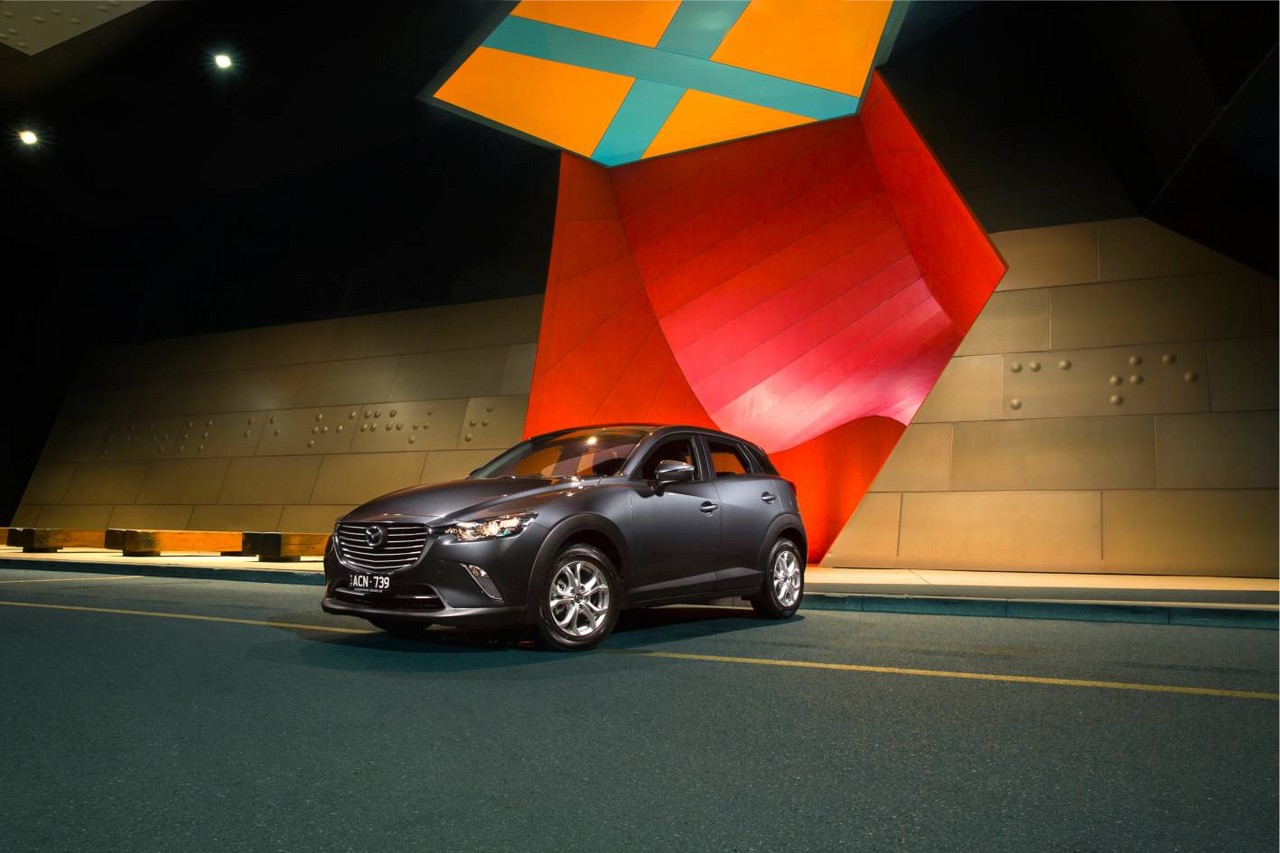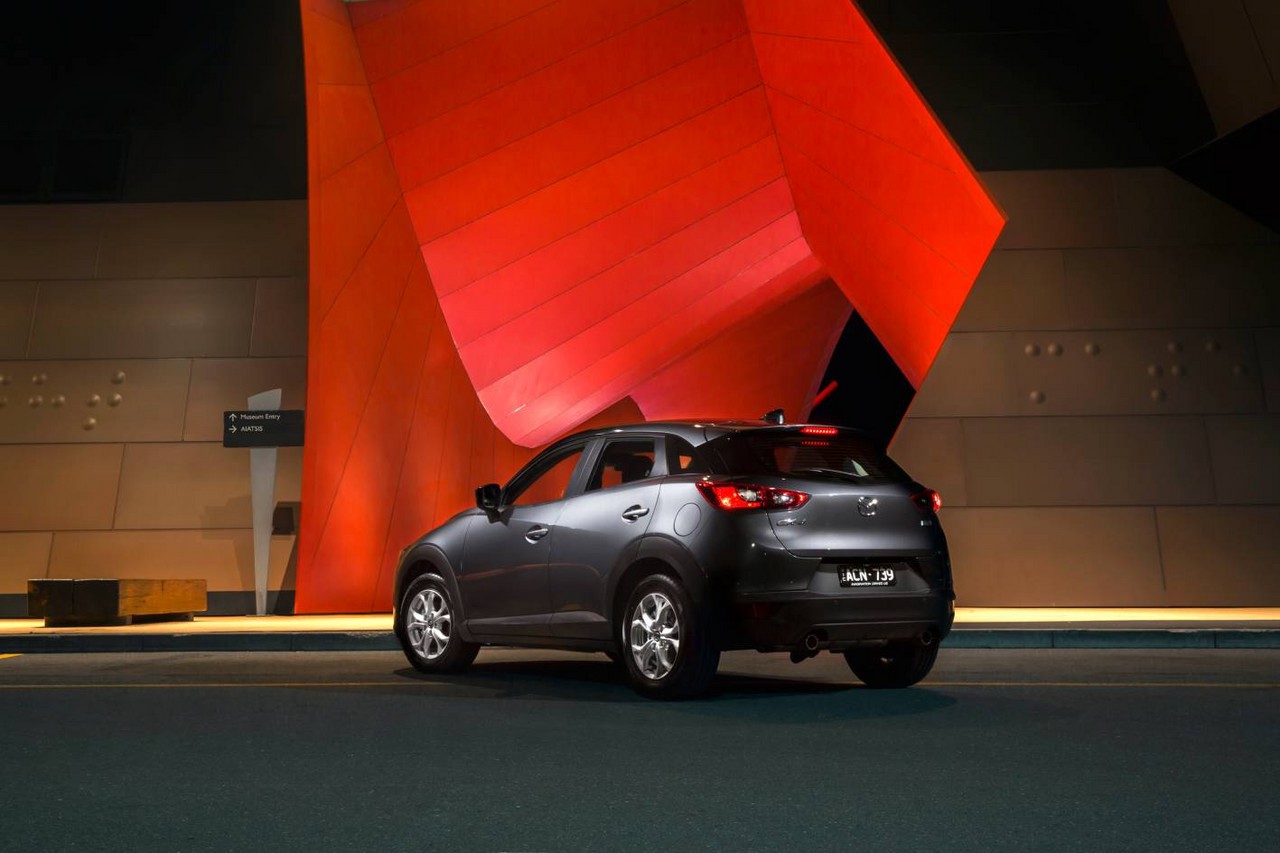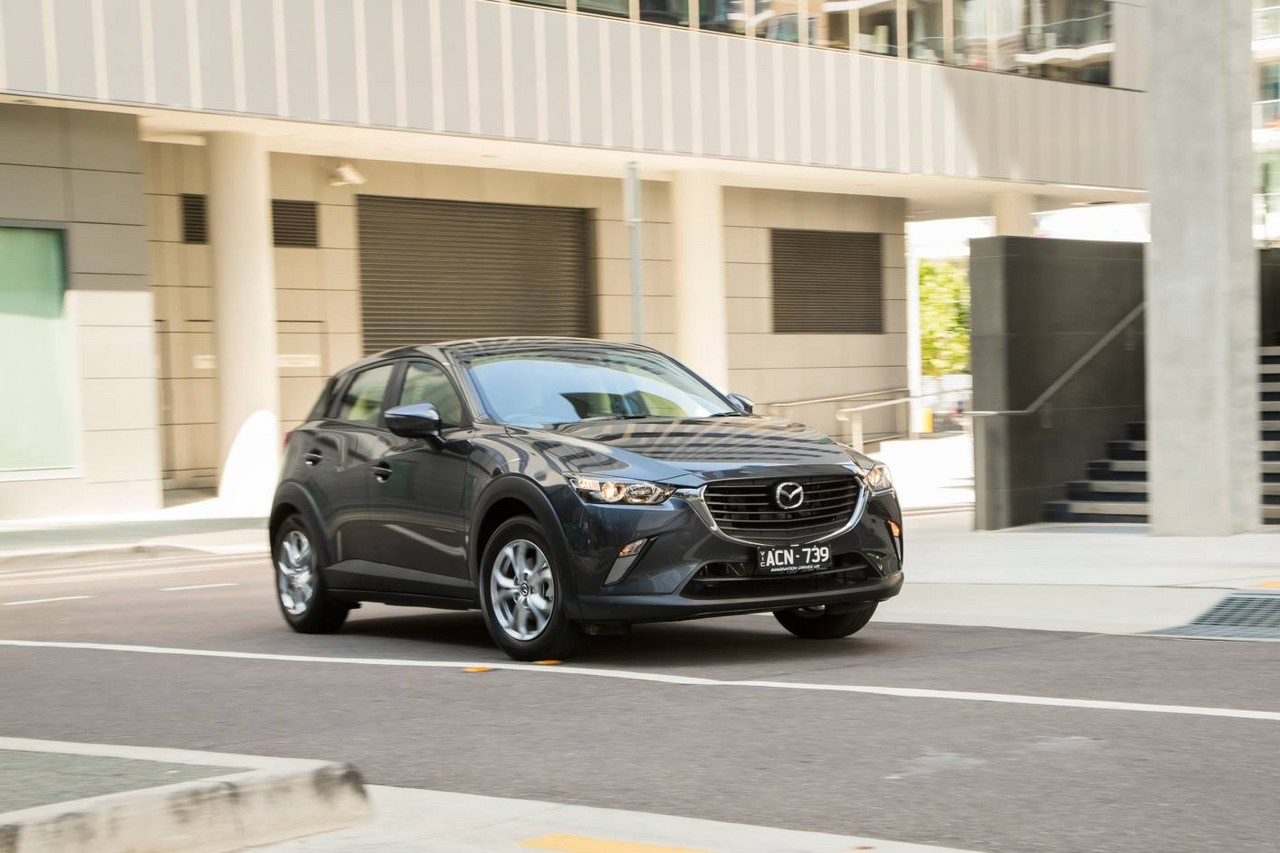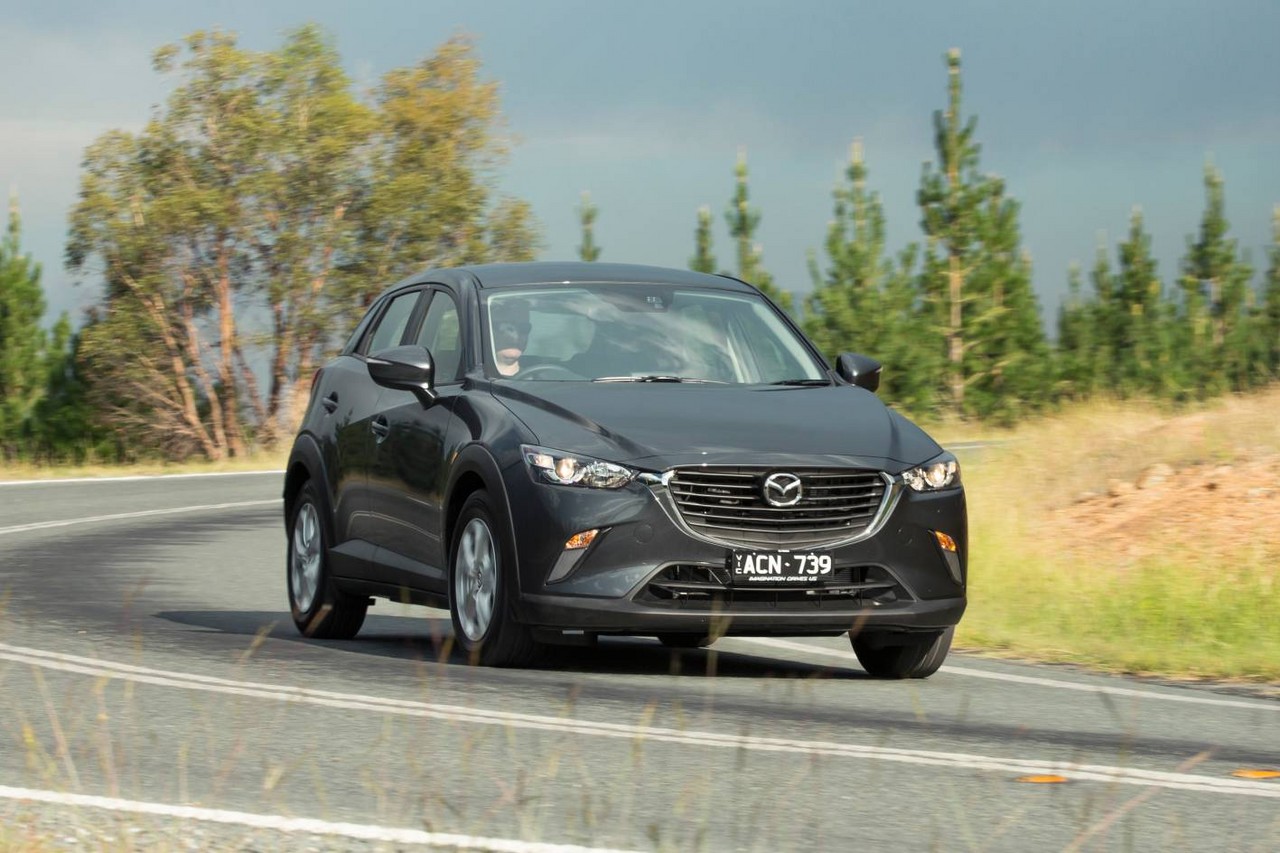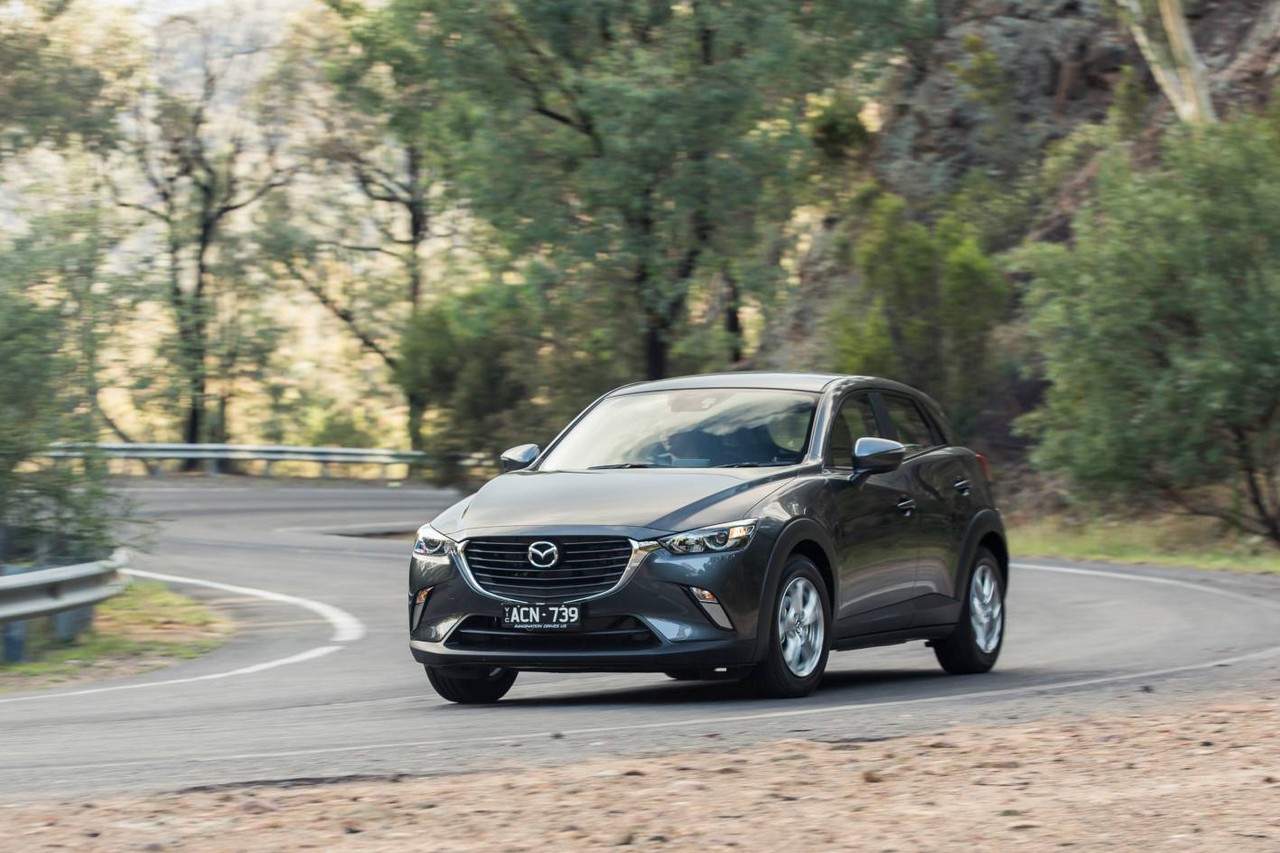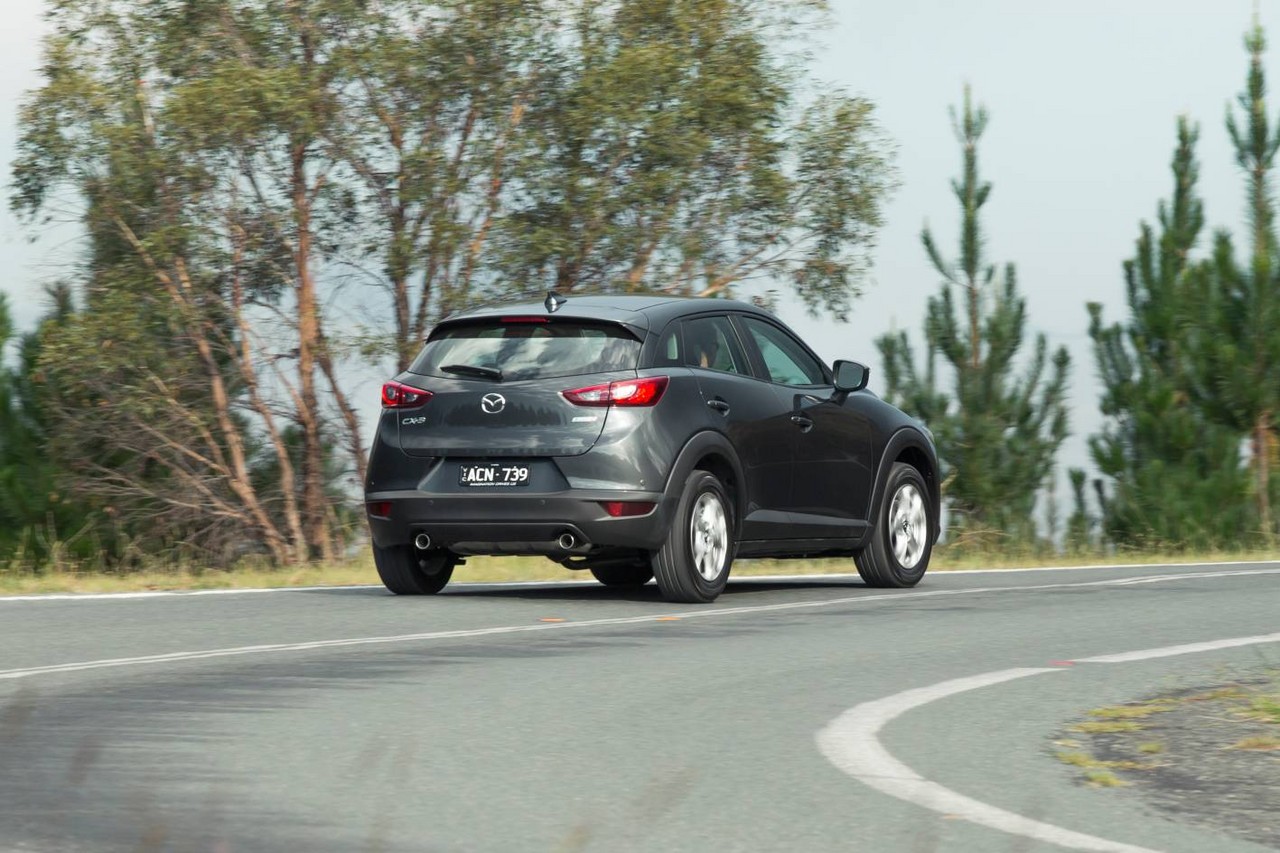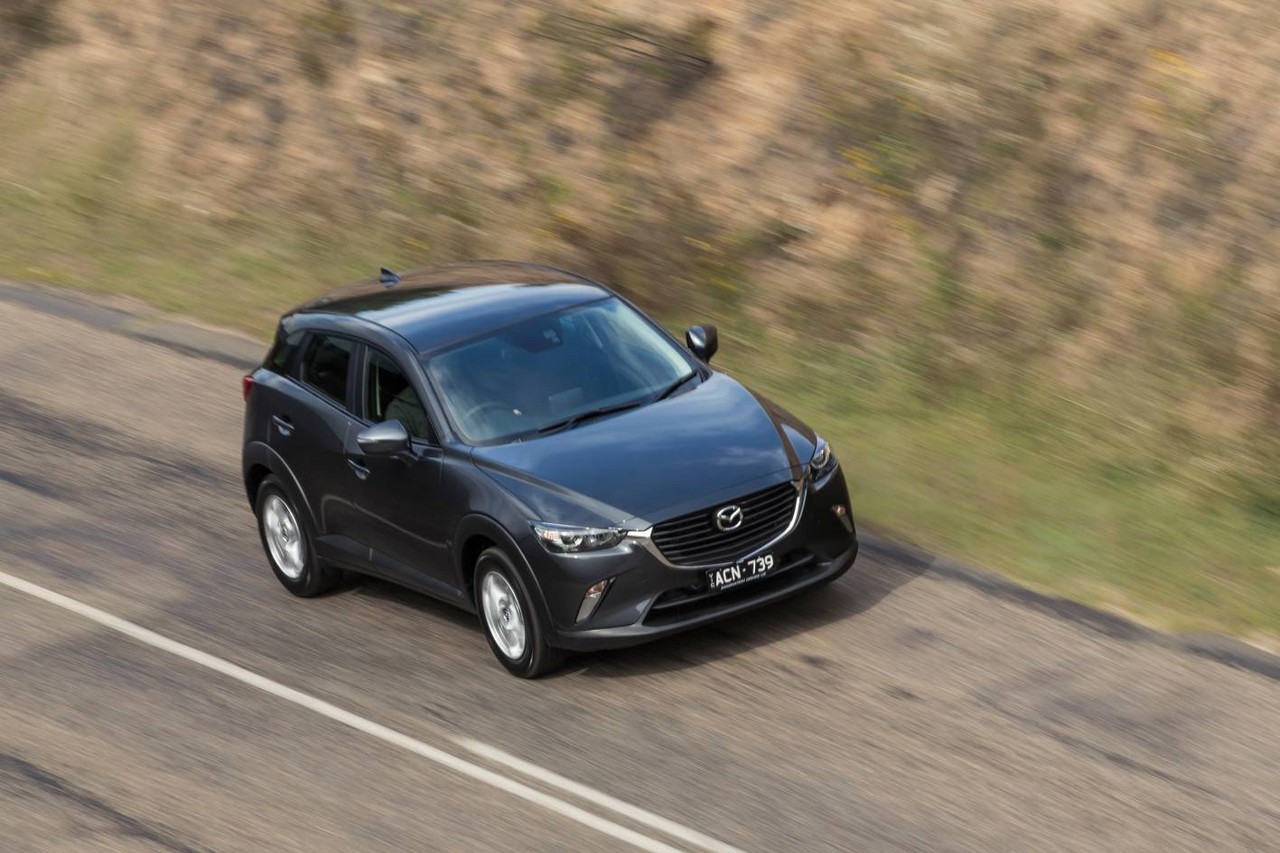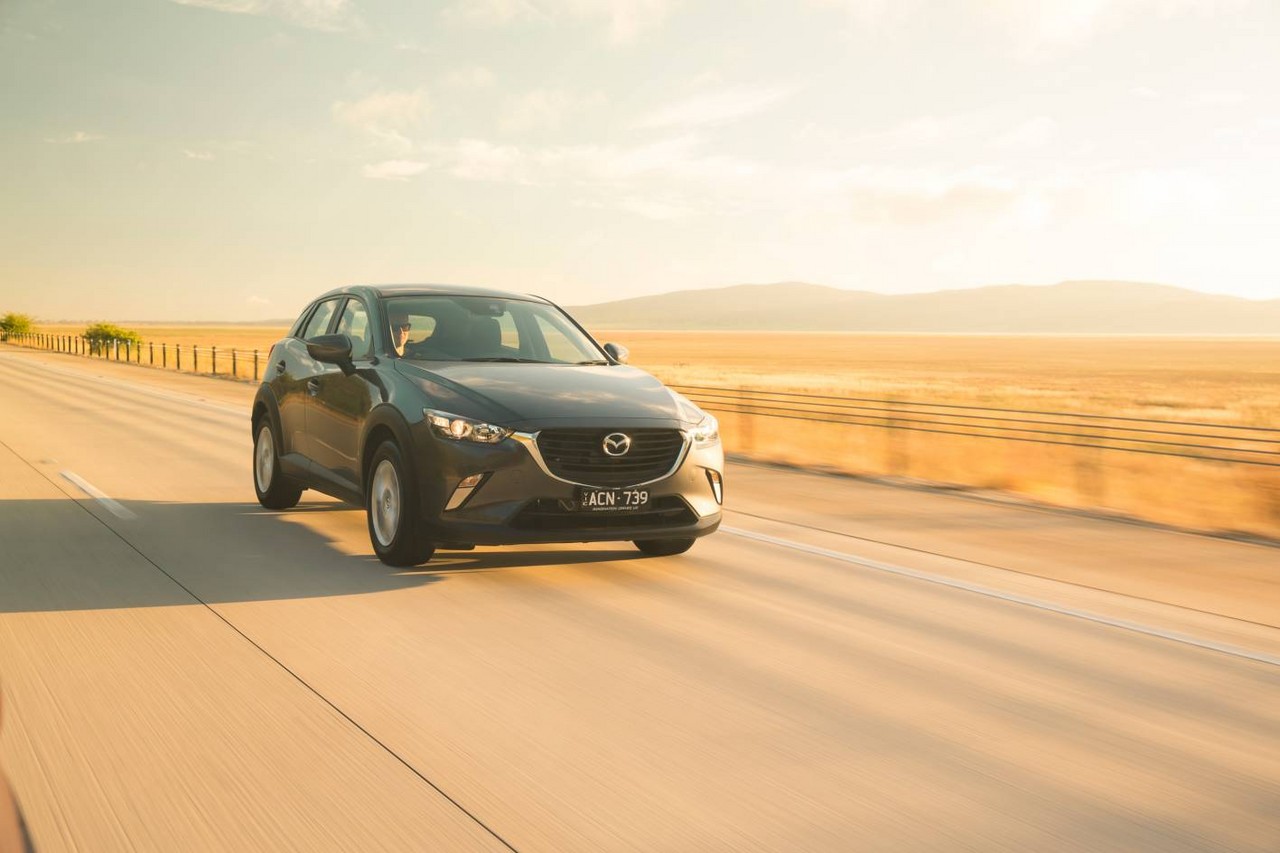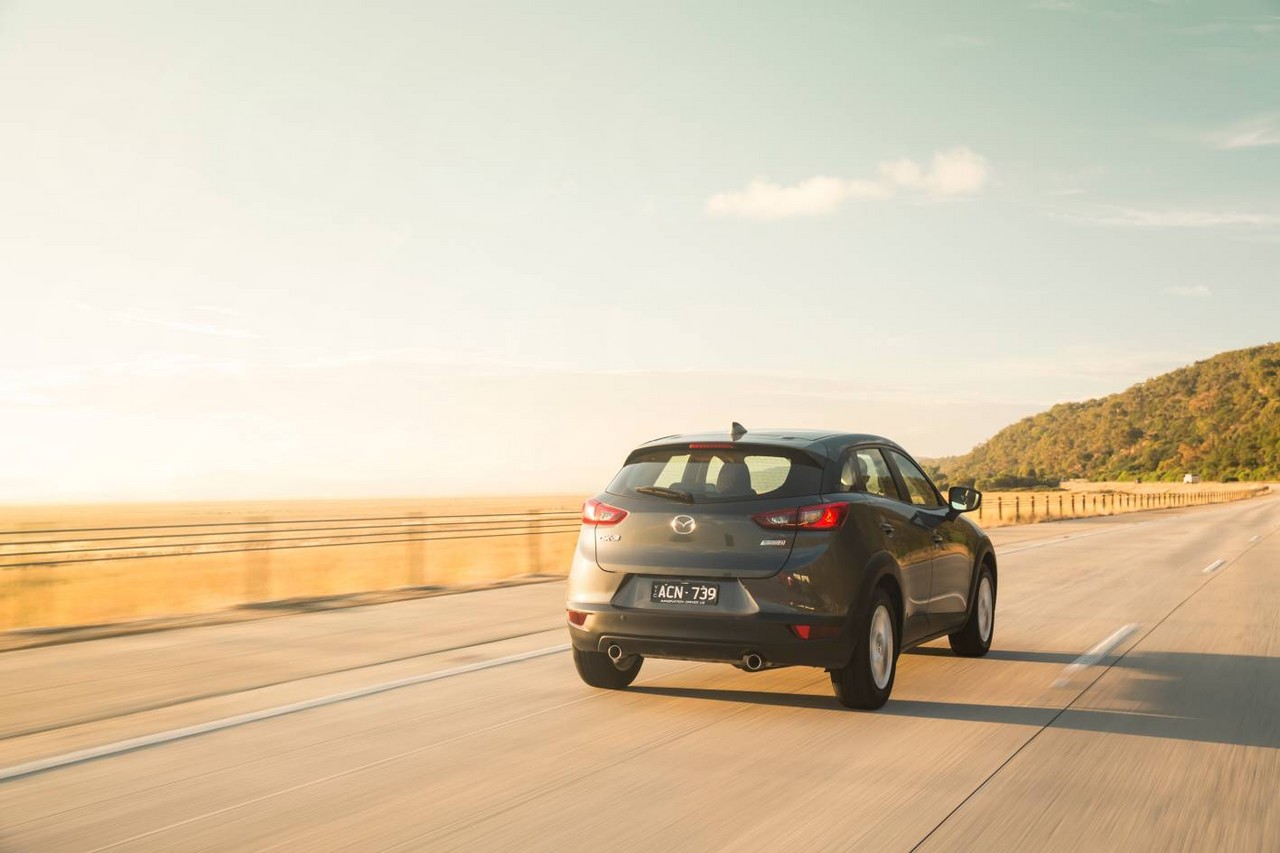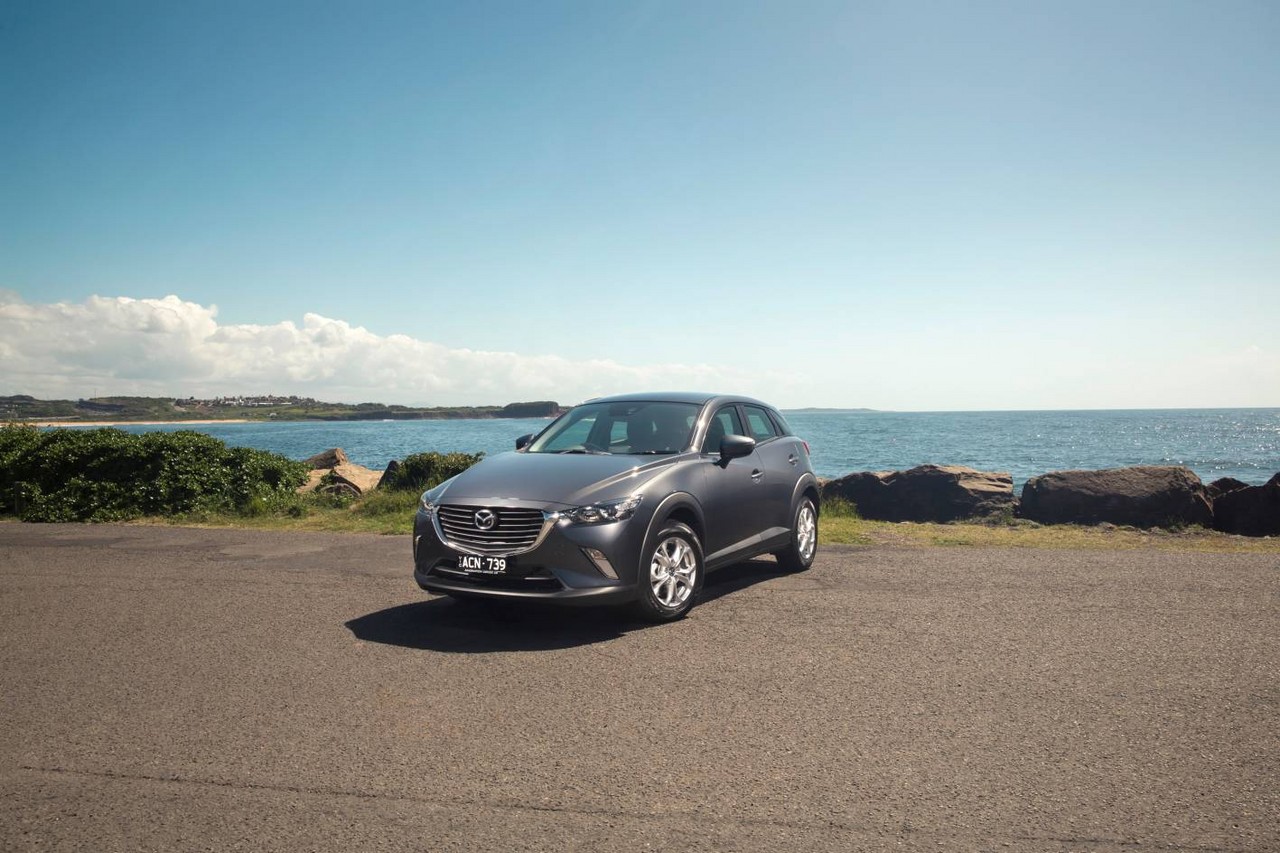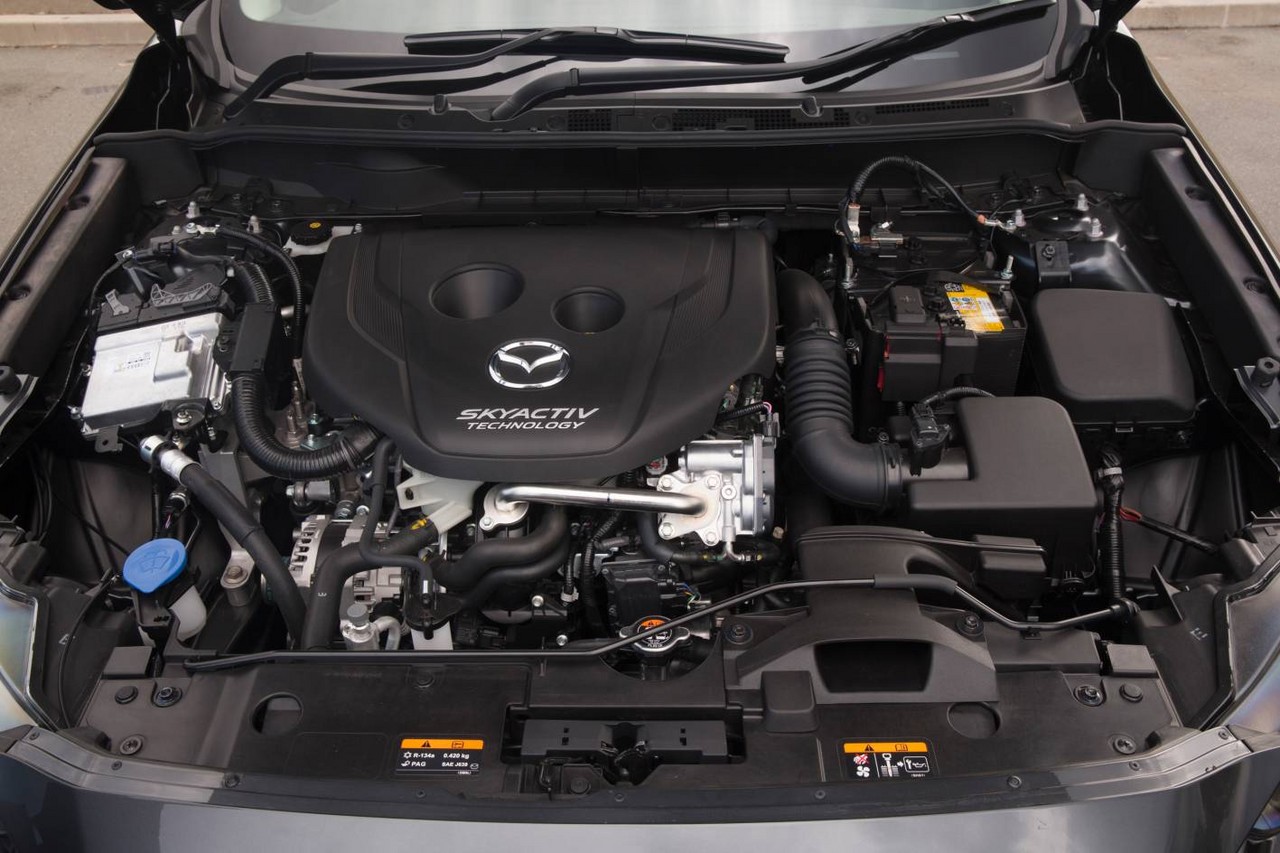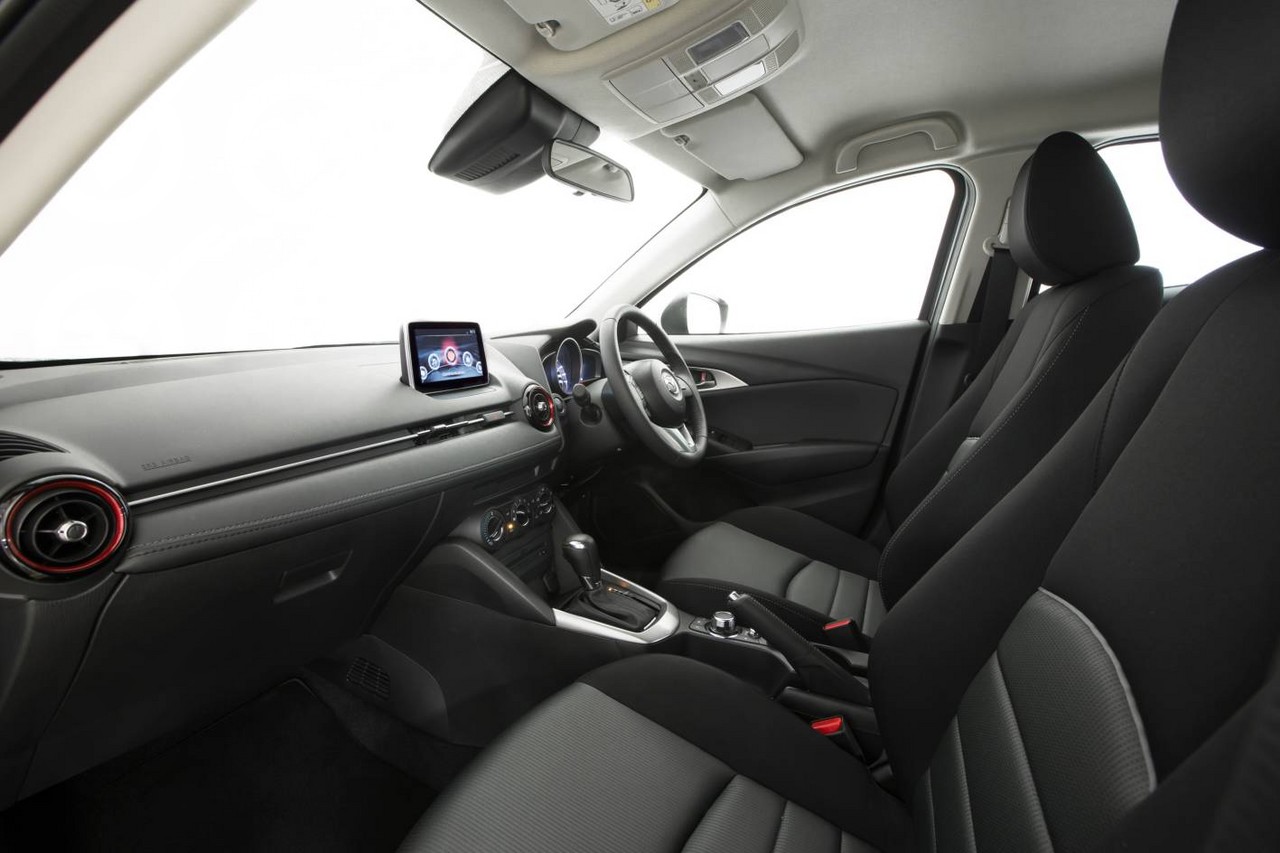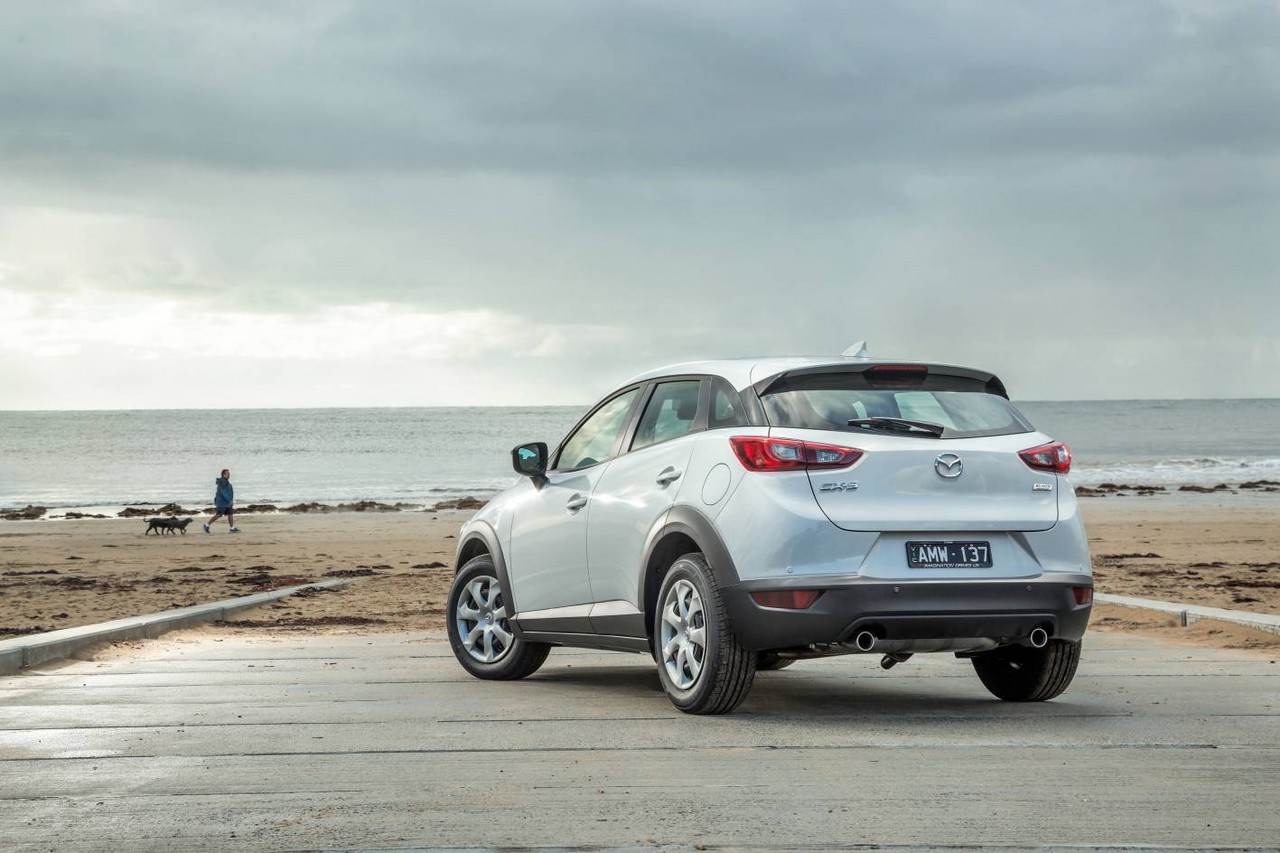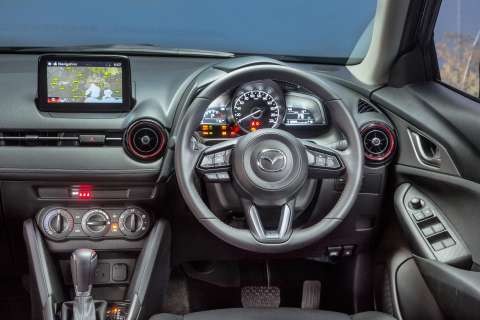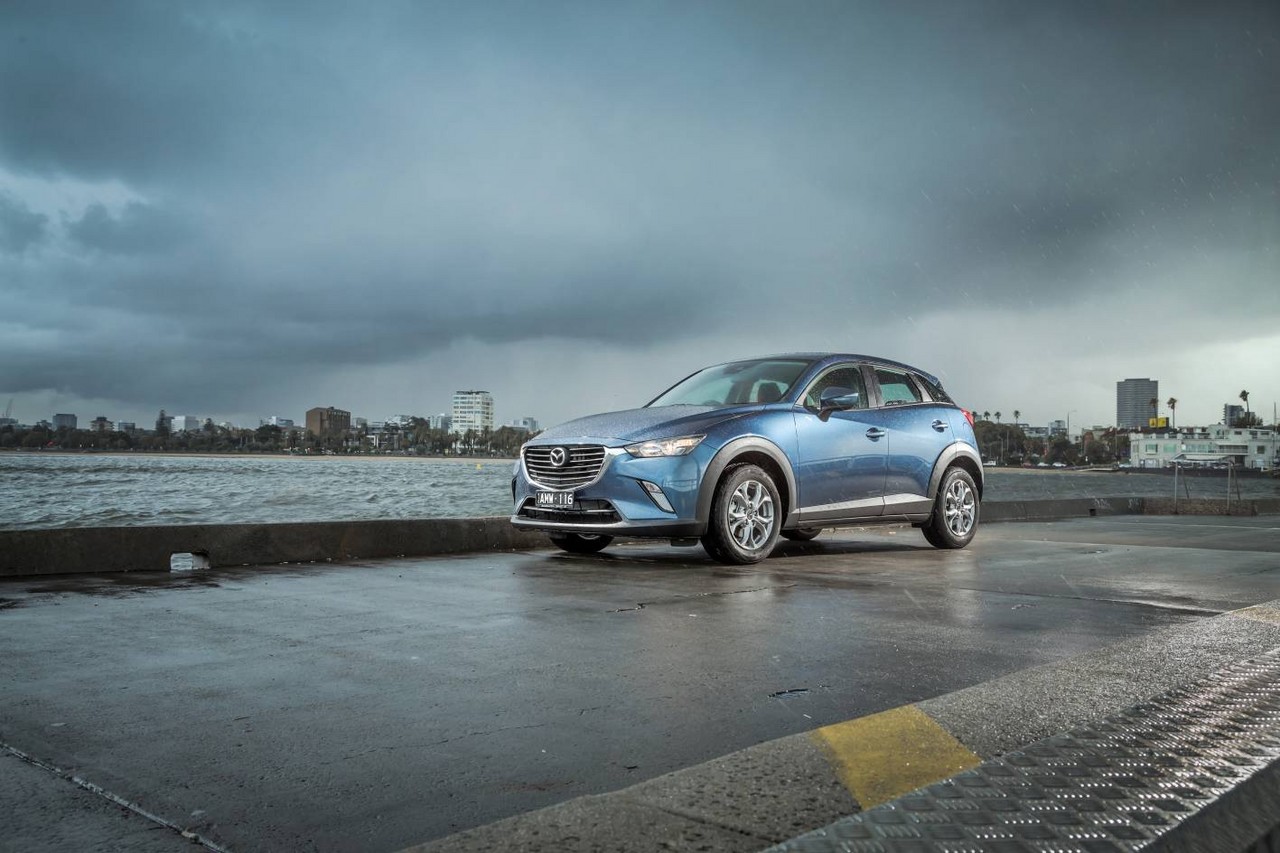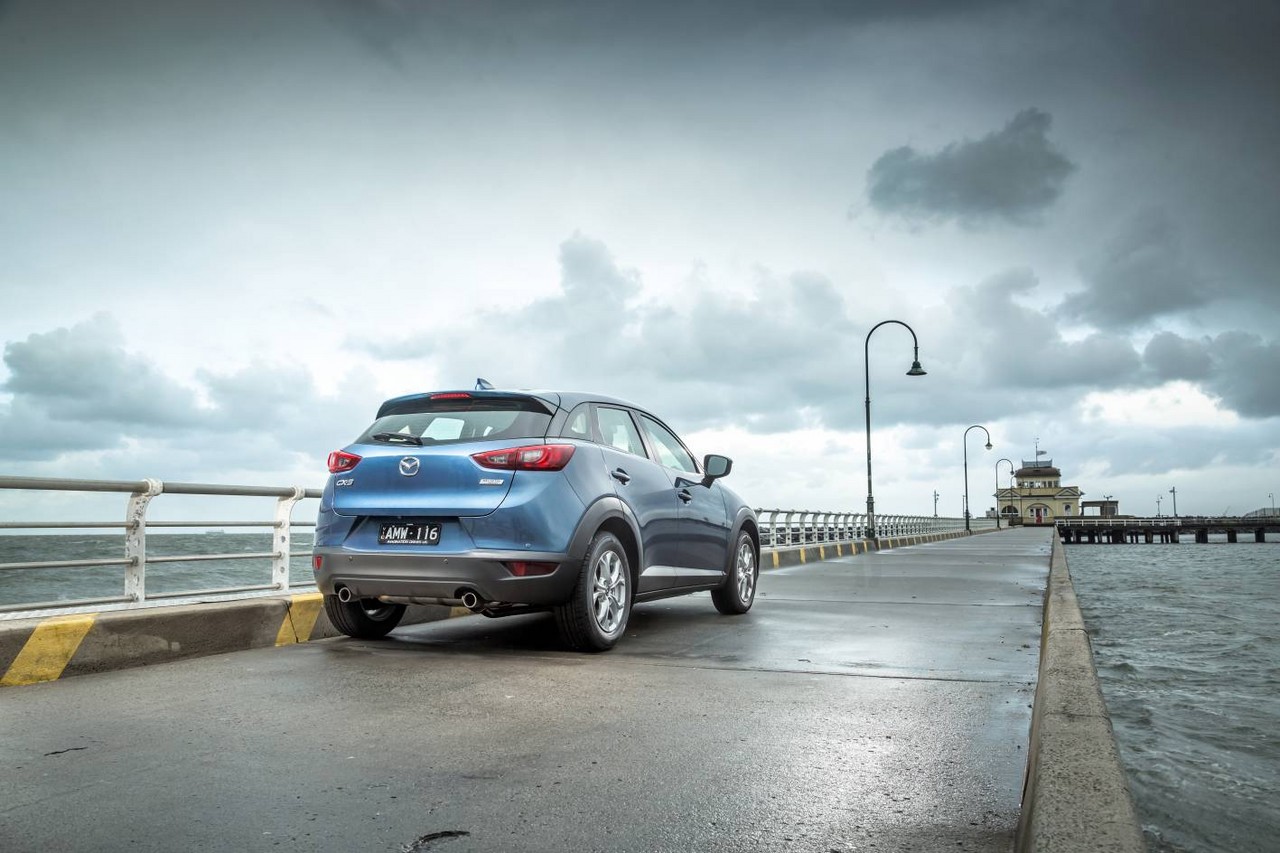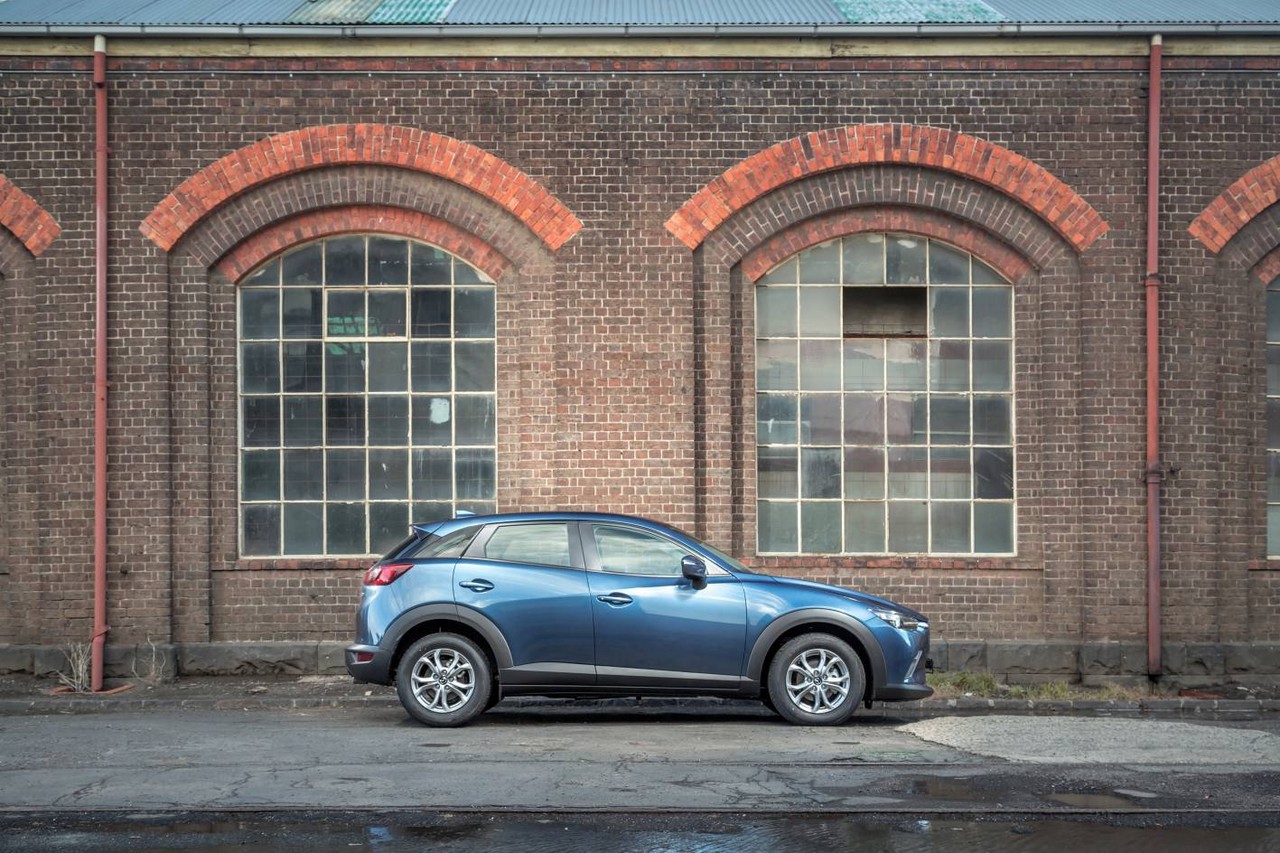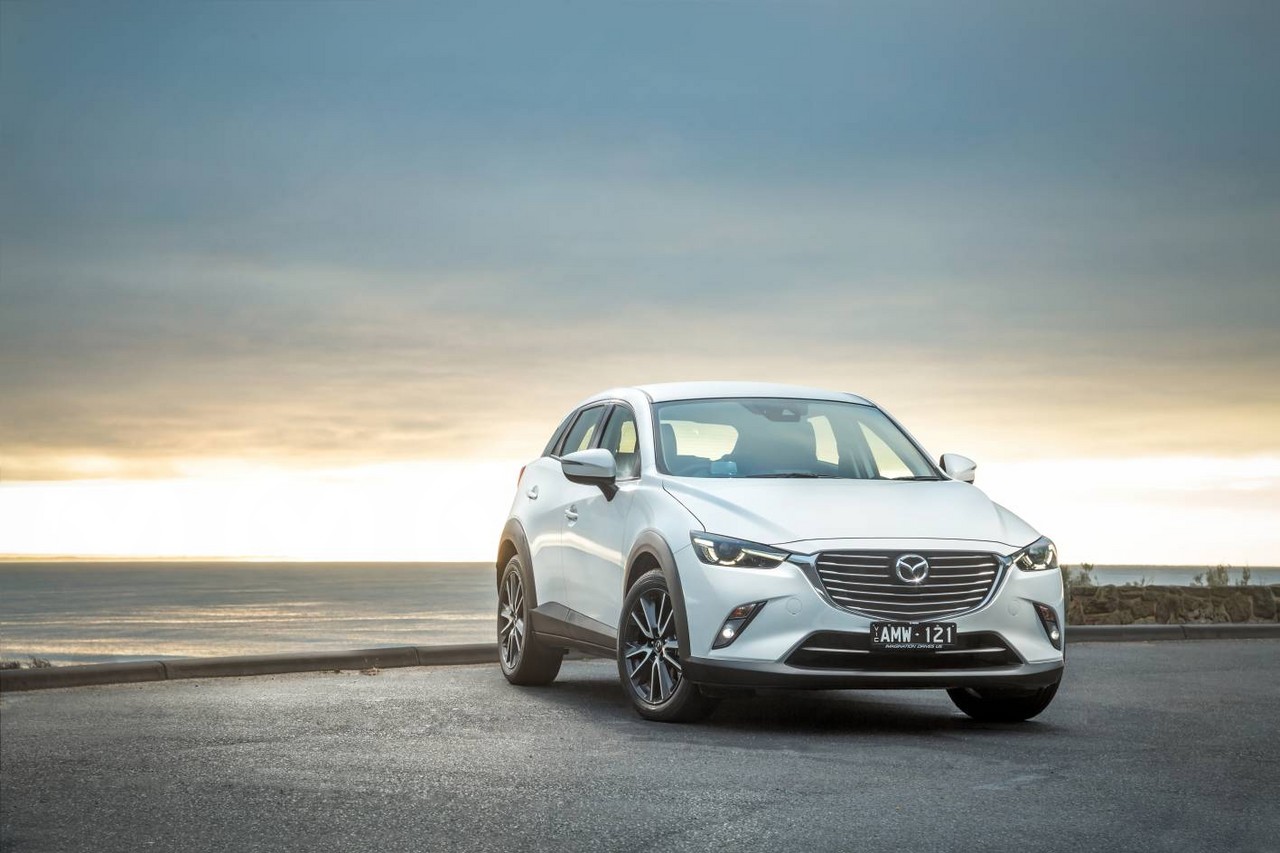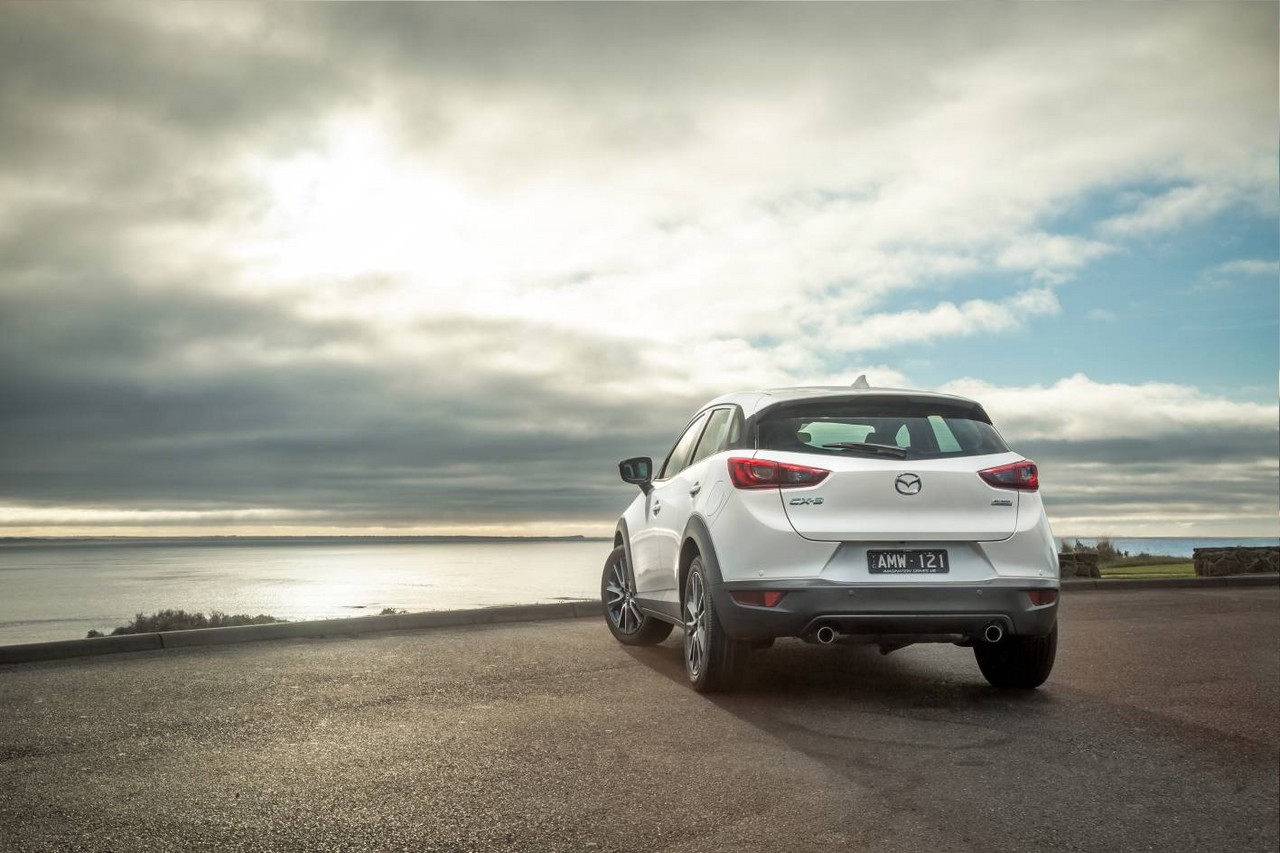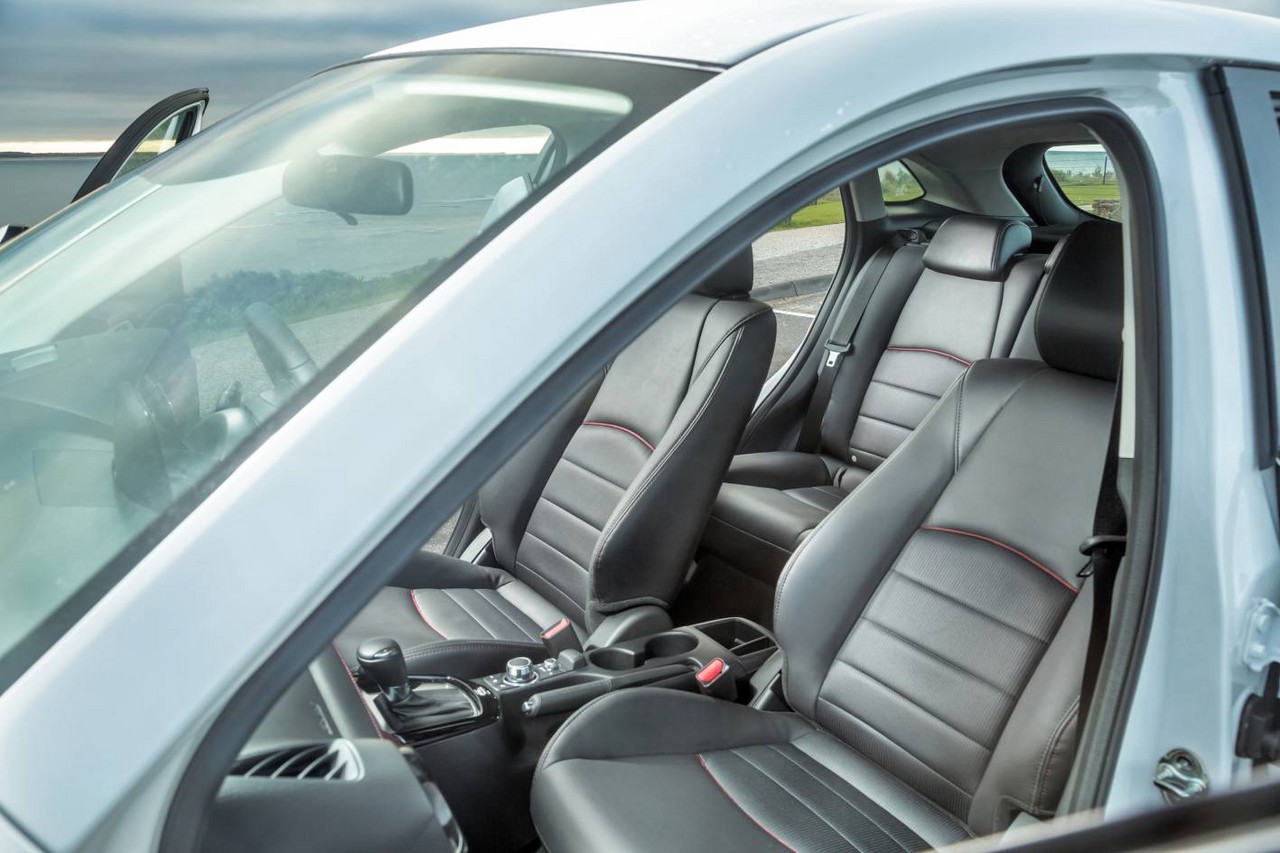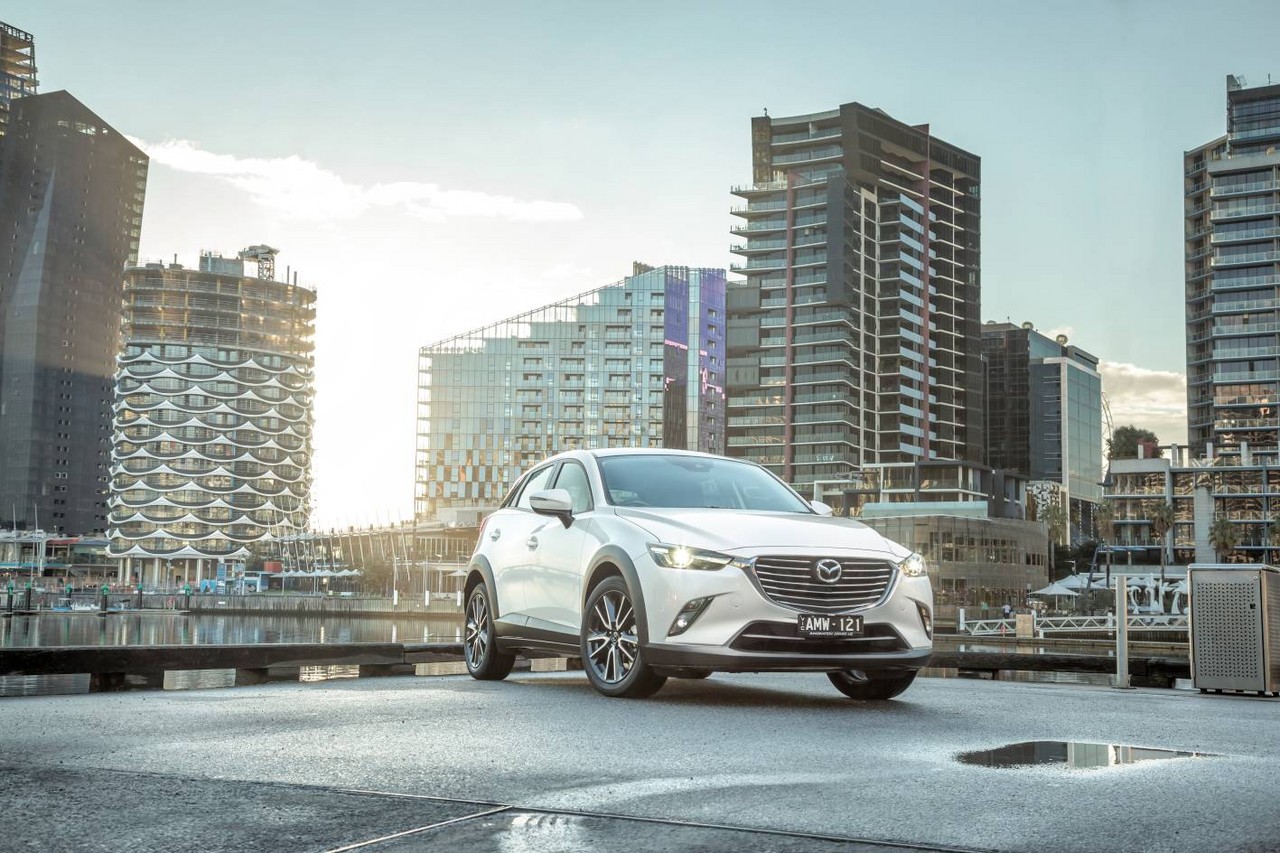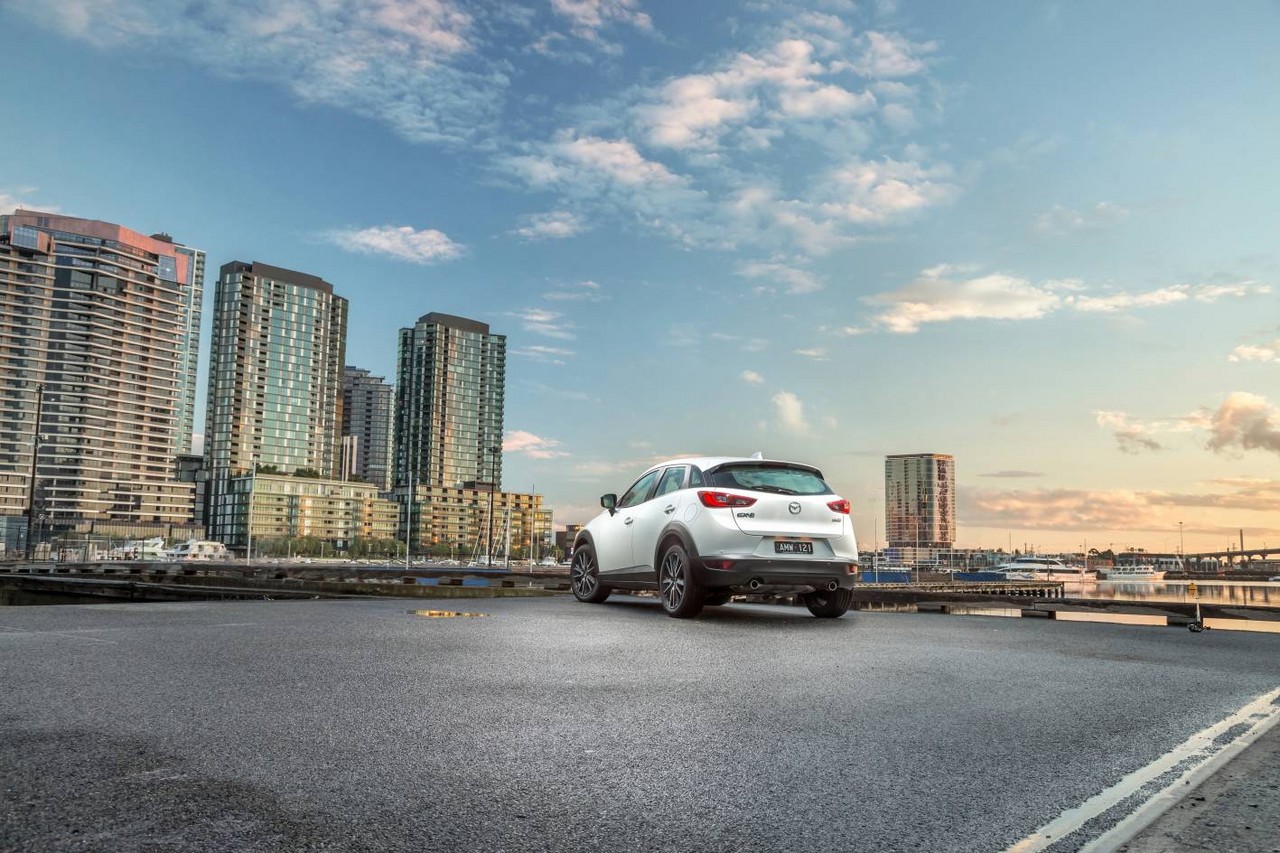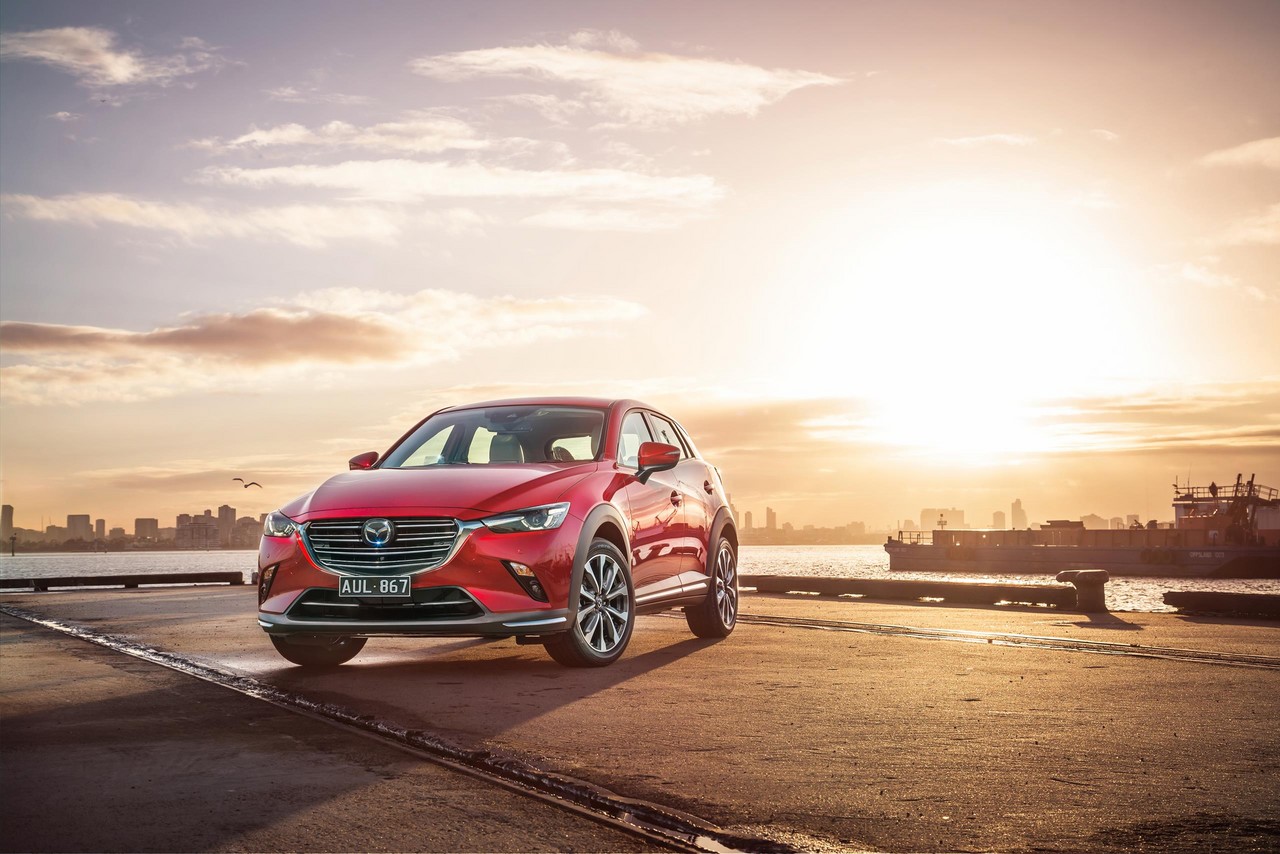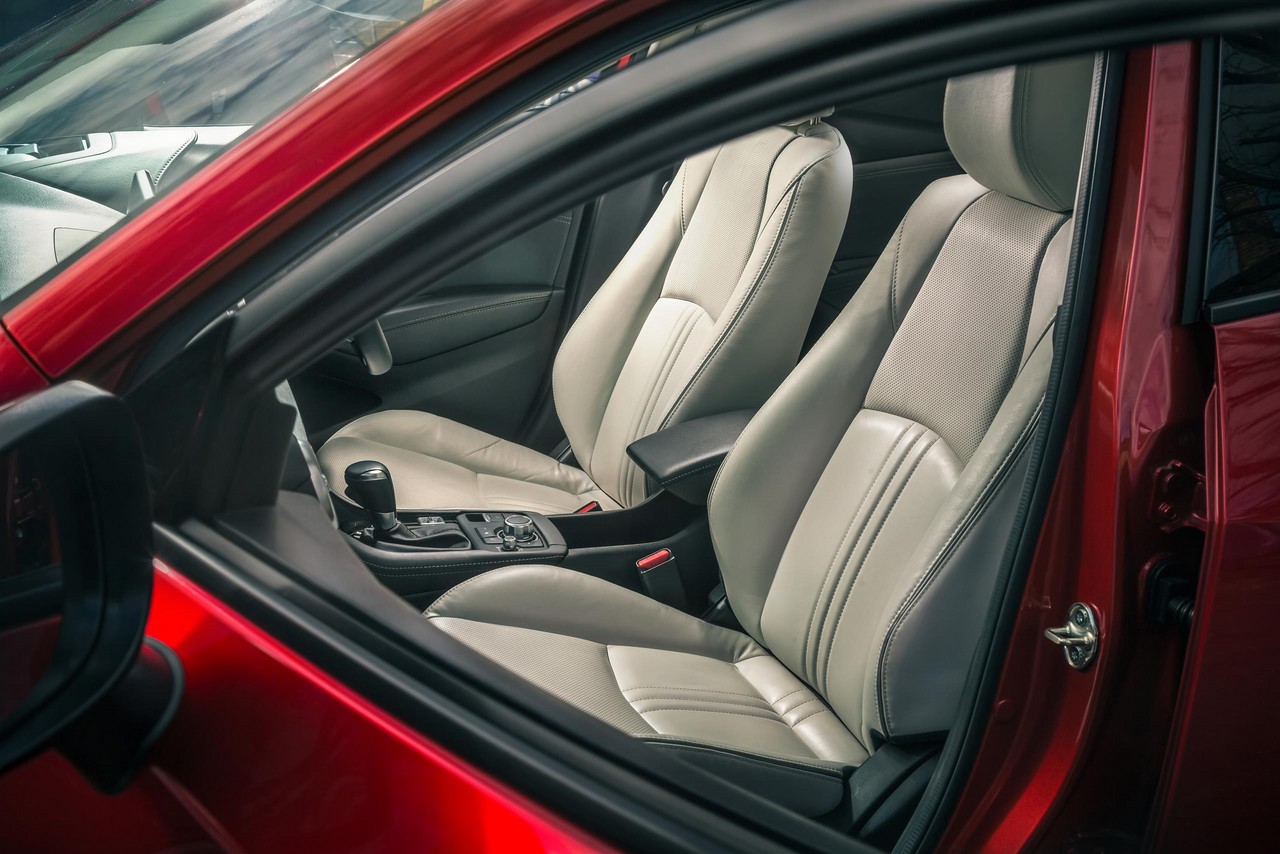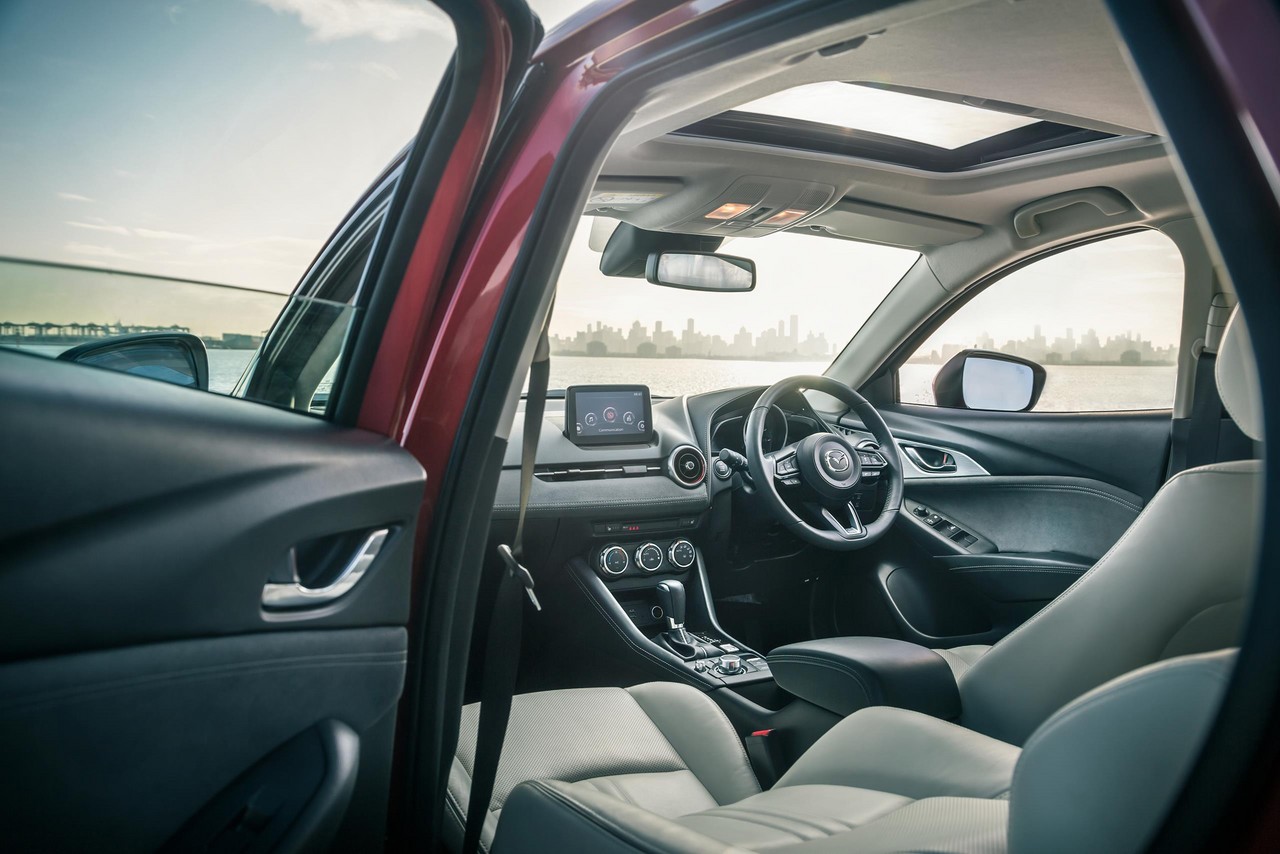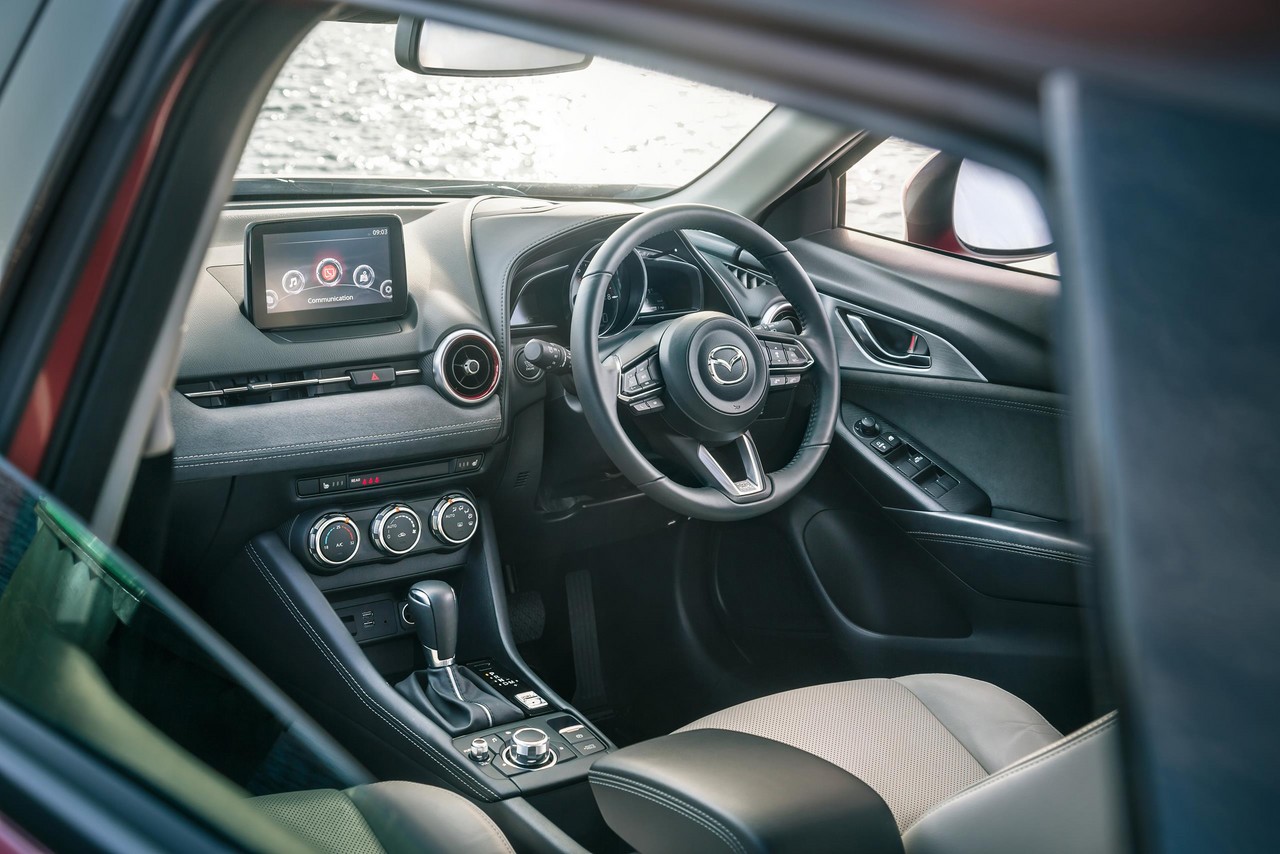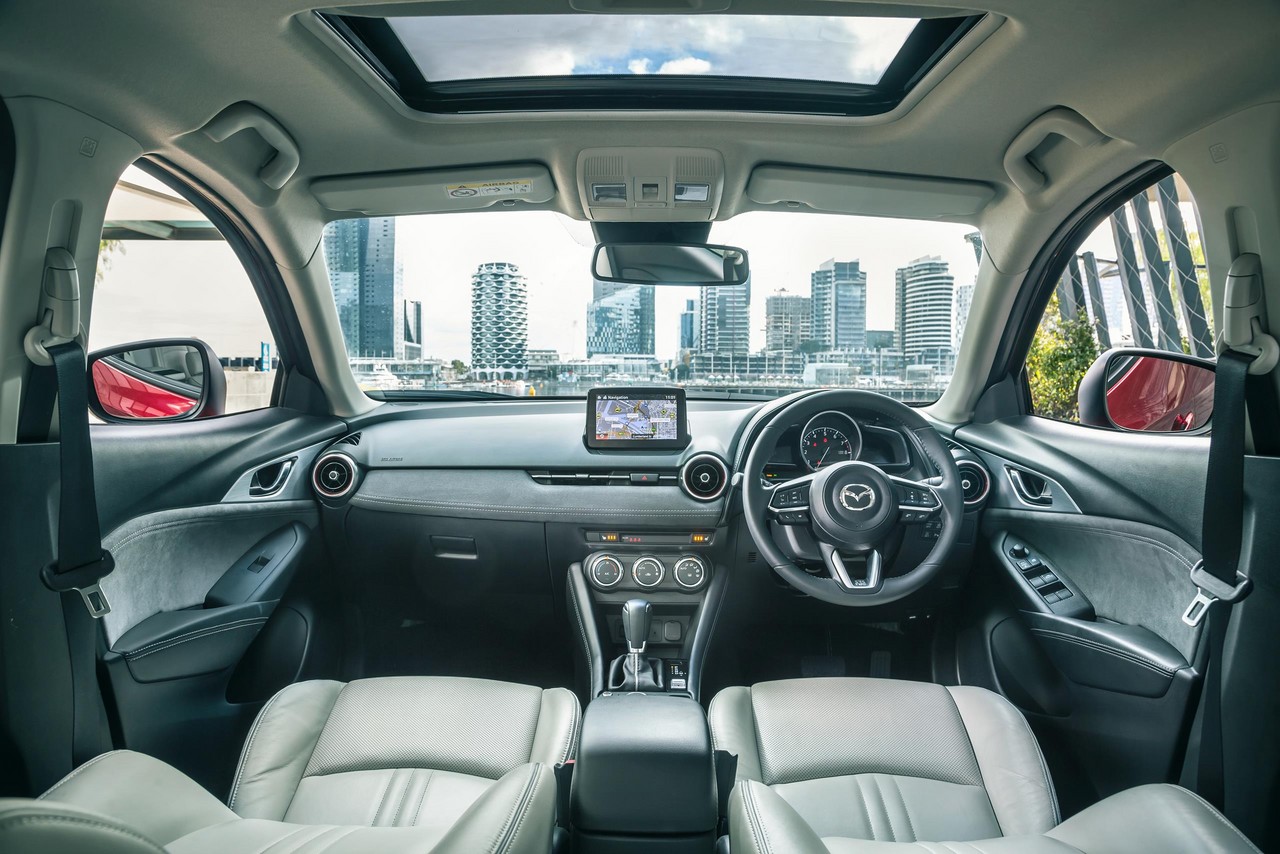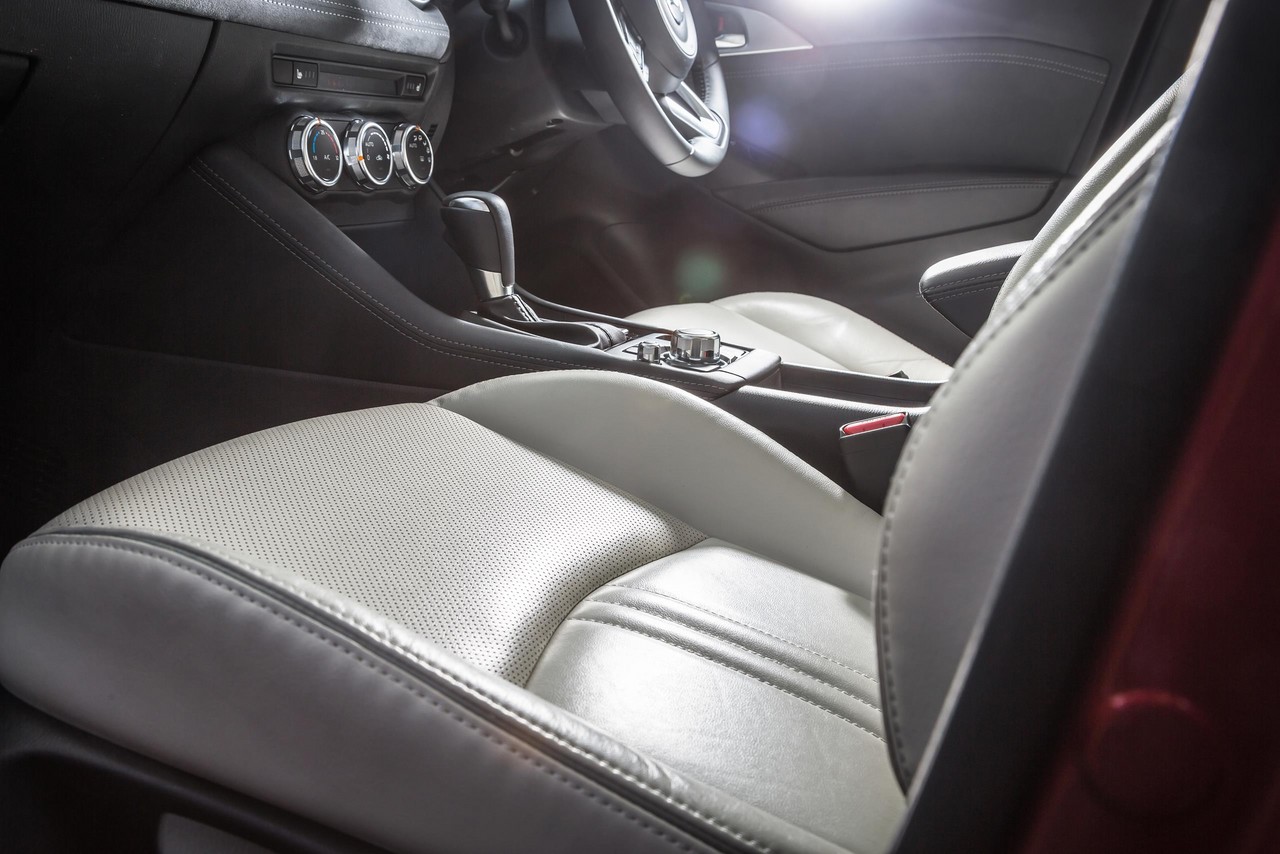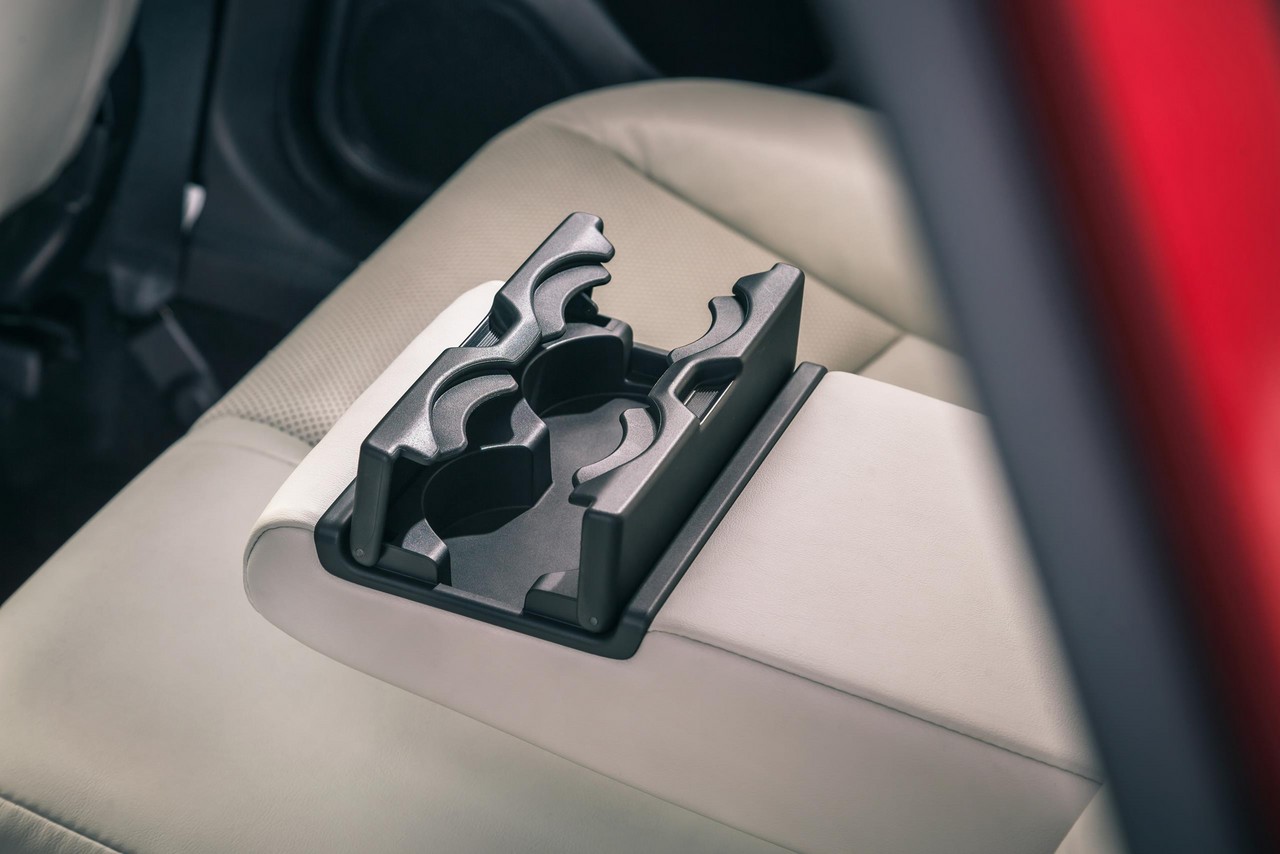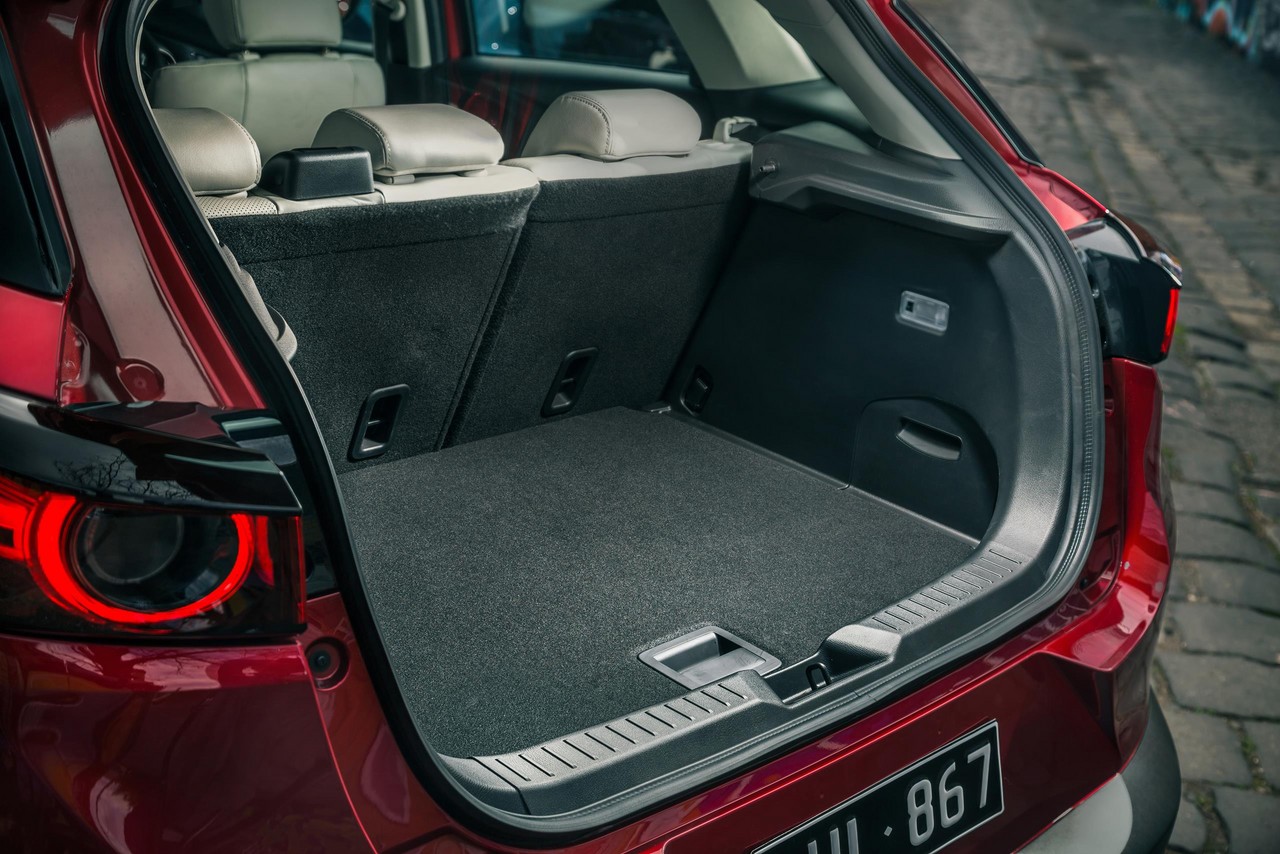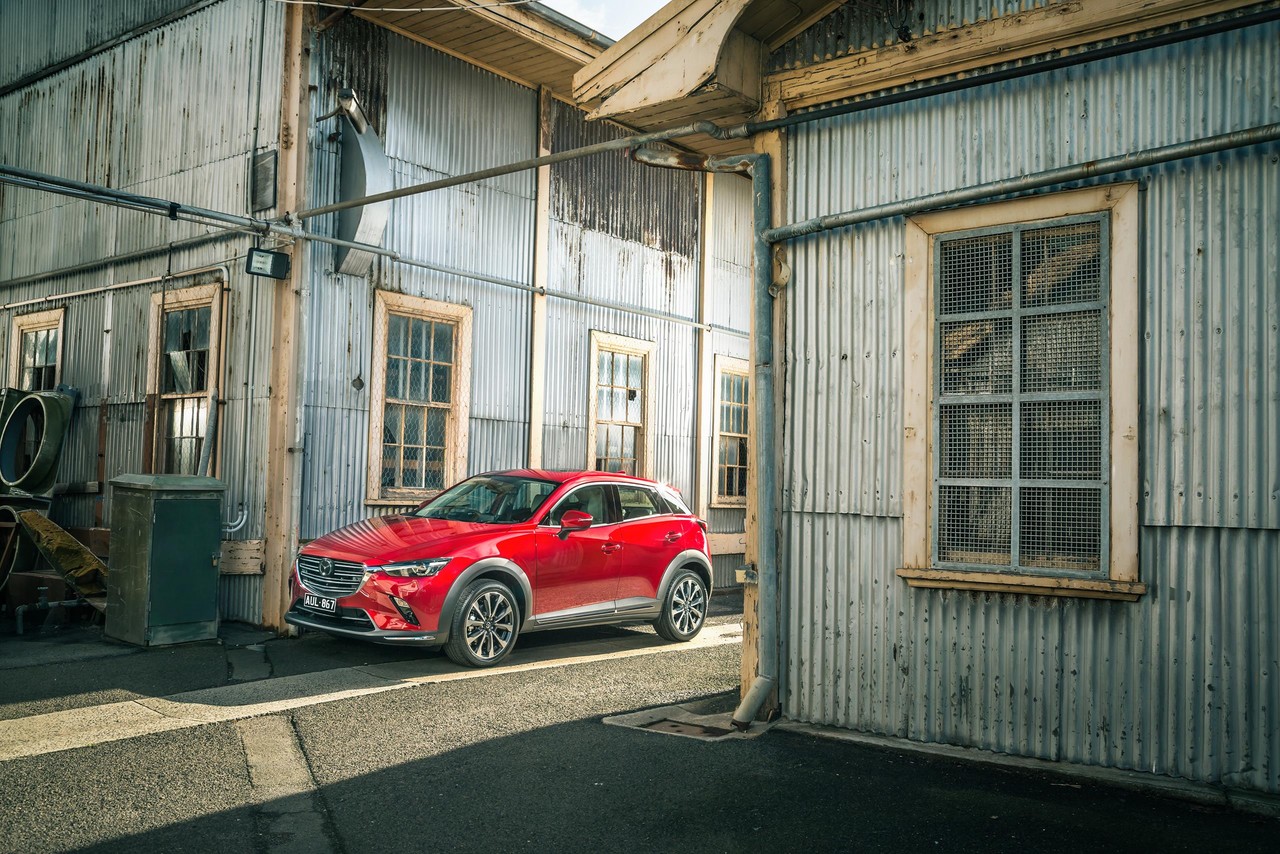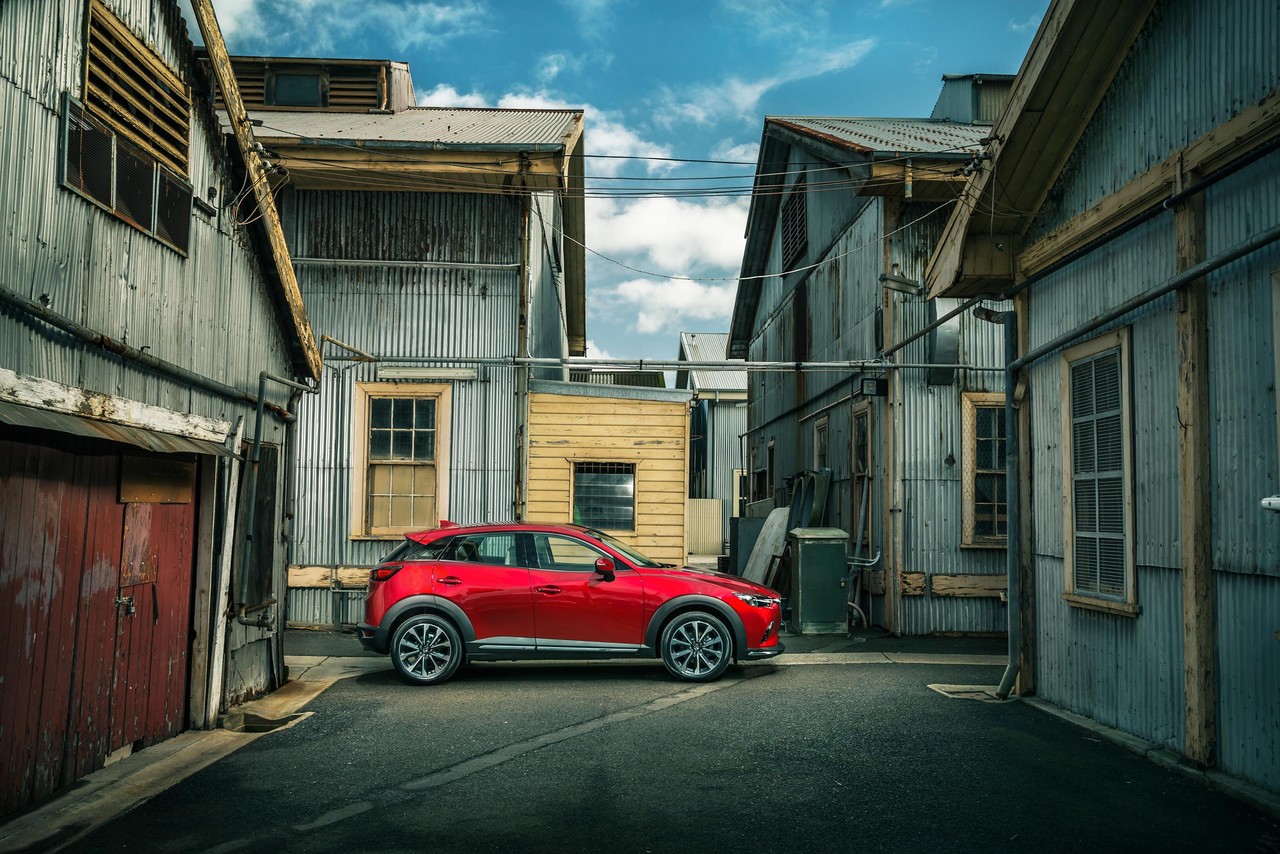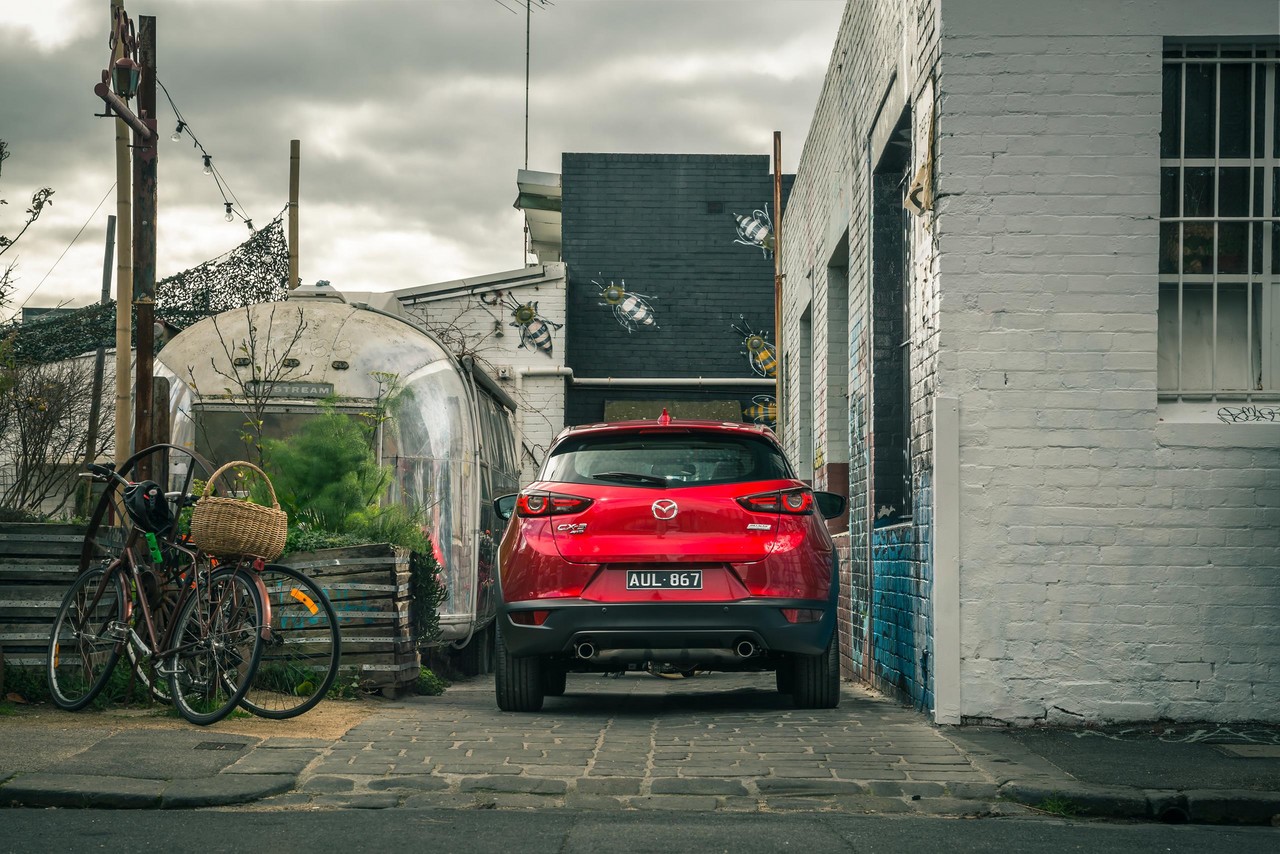
- Fuel-efficient diesel engines
- Capable dynamics
- Accurate steering
- High standard of interior fit and finish
- Cabin lacks sound insulation
- Inferior dynamics for CX-3 models with diesel engines
- Suspension lacks compliance with 18-inch wheels
- Limited cargo space
- Poor visibility for rear seat passengers
Review: Mazda DK.I CX-3 (2015-17)
Overview
Released in Australia in March 2015, the Mazda DK Series I (DK.I) CX-3 was a compact crossover vehicle. Manufactured in Japan, the Mazda DK CX-3 was available with 2.0-litre petrol and 1.5-litre turbo-diesel engines, and in front- and all-wheel drive. As per the table below, range consisted of Neo, Maxx, sTouring and Akari variants. While the Mazda CX-3 was initially manufactured at Mazda’s Hiroshima plant, it was manufactured at the Hofu plant from December 2016.
SkyActiv-G and SkyActiv-D engines
The Mazda CX-3 was available with Mazda’s 2.0-litre SkyActiv-G petrol and 1.5-litre SkyActiv-D turbo-diesel engines. Of these,
- Shared with the BM Mazda3 , the 2.0-litre PE-VPS ‘SkyActiv-G’ petrol engine had an aluminium block and cylinder head, direct fuel injection, double overhead camshafts, four valves per cylinder, variable valve timing for the intake and exhaust valves (Mazda’s ‘dual S-VT’), a balance shaft, a 4-2-1 exhaust system with an extended manifold structure to reduce residual exhaust gas in the combustion chamber and a compression ratio of 13.0:1; and,
- The 1.5-litre S5-DPTS ‘SkyActiv-D’ diesel engine had an aluminium block and cylinder head, common-rail injection, a variable geometry turbocharger, water-cooled intercooler, double overhead camshafts, four valves per cylinder and a compression ratio of 14.8:1.
Both petrol and diesel engines were fitted with Mazda’s ‘i-stop’ system which enabled them to shut down when the vehicle was stationary in traffic to minimise fuel consumption.
| Engine | Drive | Variant | Trans. | Peak power | Peak torque |
|---|---|---|---|---|---|
| 2.0-litre PE-VPS petrol I4 |
FWD | Neo, Maxx, sTouring, Akari |
6sp man., 6sp auto |
109 kW at 6000 rpm | 192 Nm at 2800 rpm |
| AWD | Maxx, sTouring, Akari |
||||
| 1.5-litre S5-DPTS turbo-diesel I4 | FWD | Maxx | 6sp auto | 77 kW at 4000 rpm | 270 Nm at 1600-2500 rpm |
| AWD | sTouring, Akari |
i-ACTIV AWD system
The Mazda CX-3 was available with Mazda’s ‘i-ACTIV’ all-wheel drive system, a pro-active (or predictive) system which AustralianCar.Reviews understands to use two electro-magnetically controlled clutches that are mounted ahead of the rear differential. In normal conditions, the engine’s torque was primarily directed to the front wheels to avoid power losses and reduced fuel economy; ‘minute’ levels of torque, however, were sent to the rear axle to prevent backlash when additional torque was directed to the rear axle.
The i-ACTIV system used twenty-seven (27) sensors to monitor driver behaviour and driving conditions, including:
- Vehicle speed;
- Accelerator position;
- Engine output;
- Acceleration and yaw;
- Steering angle and the electrical current of the steering system;
- Wheel slip;
- Gear selection;
- Brake fluid pressure;
- Road gradient; and,
- Ambient temperature and wiper operation (to determine if it was snowing or raining).
As a pro-active system, the magnetic clutches could be engaged to direct torque to the rear axle, up to a 50:50 front:rear torque split. Furthermore, the i-ACTIV AWD command module calculated the desired front:rear torque split 200 times per second. To reduce friction, the AWD system used synthetic oil that maintained its low viscosity even in cold temperatures.
Dimensions and body
Sharing its ‘Skyactiv-Body’ with the DJ Mazda2 , the Mazda CX-3 was 4275 mm long, 1765 mm wide, 1550 mm tall and had a 2570 mm long wheelbase; ground clearance was 155 mm. The body of the CX-3 consisted of:
- 63 per cent high tensile steel;
- 29 per cent ultra-high tensile steel (780 MPa or higher); and,
- 4 per cent ultra-high steel rated at 1180 MPa for the roof rails, inner roof rail members, second cross-member and part of the side sill reinforcements.
For the entry-level CX-3 Neo SkyActiv-G with manual transmission, kerb weight was 1193 kg.
Cargo capacity for the CX-3 was 264 litres with the rear seats in position, increasing to 1174 litres when they were folded forward.
Steering and suspension
The Mazda CX-3 had electric power-assisted steering, MacPherson strut front suspension and torsion beam rear suspension.
Safety equipment
Standard safety equipment for the Mazda CX-3 included dual front airbags, front side airbags, full-length curtain airbags (i.e. for front and rear occupants), ABS, electronic brake force distribution, brake assist, electronic stability control, traction control and front seatbelts with pre-tensioners and load limiters.
Fitted as standard for the Mazda CX-3 Akari and an extra-cost option for the Neo, Maxx and sTouring variants, Mazda’s ‘Safety Pack’ included the following technologies:
- Smart City Brake Support (SCBS): Operating at speeds between 4 km/h and 30 km/h, SCBS used a near-infrared sensor that was mounted in the upper part of the windshield. If a vehicle or obstacle was detected and a high risk of collision was assessed, the brakes would be pressurised. If the driver failed to take evasive action, the brakes would be automatically applied (i.e. autonomous emergency braking) to prevent or reduce the severity of the collision; and,
- Advanced Blind Spot Monitoring (ABSM) with Rear Cross Traffic Alert (RCTA): used 24GHz milliwave radar sensors to detect vehicles up to 45 metres behind the driver. If the driver indicated to change lanes and a vehicle was detected in the driver’s blind spot or approaching from behind, ABSM would issue a warning tone and activate the indicator in the relevant door mirror. For RCTA, the sensors could detect approaching traffic which may cross the vehicle’s path if it was to reverse.
The Mazda CX-3 Akari was also fitted with Mazda’s Lane Departure Warning (LDW) system which used a monocular colour camera to monitor lane markings. If the system assessed that the vehicle was about to depart from its lane due to driver fatigue or inattention, a warning tone would sound. The LDW system was not part of the Safety Pack.
Euro NCAP and ANCAP testing
In Euro NCAP testing , a left-hand drive 2015 Mazda CX-3 with a 2.0-litre petrol engine received a four star safety rating which included an 85 per cent adult occupant protection rating and a 79 per cent child occupant protection rating.
In separate crash testing conducted by ANCAP , the Mazda CX-3 received a five star adult occupant protection rating with a score of 36.44 out of 37.
Brakes
Front-wheel drive Mazda CX-3 models had 280 mm by 25 mm vented front brake discs and 281 mm by 9.5 mm solid rear discs; all-wheel drive models, however, had larger 295 mm by 25 mm vented front brake discs.
Features: Mazda CX-3 Neo
Standard features for the Mazda CX-3 Neo included 16 x 6.5J steel wheels with 215/60 R16 95V tyres, a four speaker sound system with a CD player, MP3-compatibility, auxiliary inputs (3.5 mm/USB/iPod), Bluetooth mobile phone connectivity with audio streaming, black/grey cloth seats, air conditioning, cruise control, rear parking sensors, 60/40 split and folding rear seats, remote central locking, power windows and mirrors, tilt and telescopic steering wheel adjustment, a height adjustable driver’s seat, push-button engine start, front vanity mirrors, tinted windows, a trip computer and an immobiliser. All CX-3 models were fitted with a space-saving spare wheel.
Features: Mazda CX-3 Maxx
The Mazda CX-3 Maxx was further equipped with 16-inch alloy wheels with 215/60 R16 95V tyres, a six speaker sound system, Mazda’s ‘MZD Connect’ connectivity system, a reversing camera and a leather-wrapped steering wheel and gearshift knob. In addition to SD card-based navigation, the ‘MZD Connect’ system worked in conjunction with a synchronised smartphone to provide an Internet connection and communication functions. When synchronised to a smartphone, MZD Connect had the capability to:
- access Internet Radio stations such as Aha, Pandora and Stitcher;
- use text-to-voice technology to read aloud email and short messages – including tweets and Facebook news feed entries – while the vehicle was in motion;
- post audio messages using the Shout function; and,
- enable the driver to search the Internet for locations and set them as target destinations.
Features: Mazda CX-3 sTouring
Beyond this, the Mazda CX-3 sTouring added 18 x 7.0J alloy wheels with 215/50 R18 92V tyres, black Maztex and grey cloth seats, climate control air conditioning, LED headlights, LED daytime running lights, LED front fog lights, LED tail-lights, automatic headlights, rain-sensing wipers, proximity key (for keyless entry) and Mazda’s ‘Active Driving Display’, a head-up display which projected speed, navigation directions and other driving information onto a clear panel mounted above the instrument cluster.
Features: Mazda CX-3 Akari
In addition to its additional safety equipment, the Mazda CX-3 Akari was distinguished by its combination black leather and suede seats, power-operated glass sunroof and ‘High Beam Control’ function which automatically switched the headlights from high- to low-beam when oncoming vehicles were detected.
Paint colours
The Mazda CX-3 was available in the following paint finishes:
- Crystal White Pearl Mica;
- Soul Red Metallic;
- Jet Black Mica;
- Meteor Grey Mica;
- Deep Crystal Blue Mica;
- Titanium Flash Mica;
- Dynamic Blue Mica; and,
- Ceramic Metallic.
Brochure
Review: Mazda DK.II CX-3 (2017-18)
Overview
Officially released in Australia in May 2017, the Mazda DK Series II (DK.II) CX-3 introduced additional safety equipment, revised suspension, greater sound insulation, G-Vectoring Control and enhancements for the SkyActiv-D diesel engine (described below). Other changes included:
- A newly designed steering wheel (previously introduced in the Mazda TC CX-9 );
- More legible instrument dial graphics; and,
- The introduction of an ‘Eternal Blue Mica’ paint finish (replacing Crystal White Pearl).
G-Vectoring Control
The Mazda DK.II CX-3 introduced Mazda’s ‘G-Vectoring Control’ (GVC) which, as the steering wheel was turned, would slightly reduce torque – usually by 0.01 g or less – to the front wheels to generate a small shift in load to the front axle and improve cornering response.
SkyActiv-D enhancements
For the Mazda DK.II CX-3, the SkyActiv-D engine introduced the following technologies:
- Mazda’s ‘High-Precision DE Boost Control’ which provided more precise control of engine torque response by ‘optimising boost pressure control’ and enabling finer adjustment of fuel injection. According to Mazda, High-Precision DE Boost Control more accurately interpreted accelerator pedal inputs and provided more linear acceleration;
- Mazda’s ‘Natural Sound Smoother’ which sought to cancel piston vibration that was generated by extension and retraction of the connecting rod during combustion by placing a damper in the hollow part of the piston pin; and,
- Mazda’s ‘Natural Sound Frequency Control’ which reduced engine knock by controlling injection timing so that sound waves introduced at pre-combustion, main combustion and post-combustion cancelled each other out.
| Engine | Drive | Variant | Trans. | Peak power | Peak torque |
|---|---|---|---|---|---|
| 2.0-litre PE-VPS petrol I4 |
FWD | Neo, Maxx, sTouring, Akari |
6sp man., 6sp auto |
109 kW at 6000 rpm | 192 Nm at 2800 rpm |
| AWD | Maxx, sTouring, Akari |
||||
| 1.5-litre S5-DPTS turbo-diesel I4 | FWD | Maxx | 6sp auto | 77 kW at 4000 rpm | 270 Nm at 1600-2500 rpm |
| AWD | sTouring, Akari |
Interior noise
To reduce interior noise, the Mazda DK.II CX-3 introduced thicker floor mats, an additional layer of sound insulation for the dashboard panel, expanded glass wool insulation beneath the floor tunnel, thicker material for the C-pillar trim seals and a new sound-absorbing material for the boot side trim panels. For DK.II CX-3 models with petrol engines, the characteristics of the number three engine mount stopper were changed to reduce vibrations around 2500 rpm.
To reduce wind noise, measures included the fitment of pads to fill the door latch cable gaps on the upper sections of the front doors, adoption of larger rear door hole covers to reduce the size of the holes through which the latch cables passed, thicker rear window glass (from 2.8 mm to 3.1 mm) and additional sound-absorbing material for the back of the trim panels on the liftback header section.
Suspension and steering changes
The Mazda DK.II CX-3 introduced a range of suspension changes:
- To reduce jarring and improve ride quality, the valving for the front and rear dampers was revised;
- For the front suspension’s lower arms, changes to the rear bushings’ prying characteristics were made to give a firmer stroke feeling. Bushing specifications were also changed to position the arm in the centre of the bushing when the suspension was under load to improve ride comfort; and,
- To reduce rear tyre skip and enhance stability, the insertion angle of the torsion beam axle bushings was changed to ensure the rear suspension followed the action of the front suspension.
For the DK.II CX-3, characteristics of the Electronic Power Assist Steering (EPAS) were also revised to improve steering response.
Safety equipment
For the Mazda DK.II CX-3, Mazda’s ‘Smart City Brake Support Forward and Reverse’ (SCBS F/R) was made standard across the range. Operating at speeds between 4 km/h and 80 km/h, SCBS Forward used forward-sensing camera to detect pedestrians and vehicles in front of the vehicle. When an obstacle was detected and a high risk of collision was determined, the brakes would be applied automatically to avoid or reduce the severity of the collision. The SCBS Reverse function used ultrasound sensors in the rear bumper to detect obstacles up to two metres behind the vehicle. It is understood that SCBS Reverse operated at speeds between 2 km/h and 8 km/h.
As standard, the Mazda DK.II CX-3 Maxx, sTouring and Akari were further equipped with –
- Blind Spot Monitoring (BSM): used 24 GHz milliwave radar sensors to detect vehicles up to 45 metres away that were approaching from behind the Mazda CX-3. If the driver activated a turn signal to change lanes and a vehicle was in the driver’s blind spot, a visual indicator in the respective door mirror would flash and a warning tone would sound; and,
- Rear Cross Traffic Alert (RCTA): as the driver was reversing, RCTA used the rear radar sensors to detect traffic that may cross the vehicle’s path. If detected, a visual indicator in the respective door mirror would flash and a warning tone would sound.
Beyond this, the DK.II CX-3 sTouring and Akari added –
- Driver Attention Alert (DAA): operating at speeds above 65 km/h, the DAA system would initially observe driver behaviour – such as steering wheel operation, vehicle speed and lane positioning – for 20 minutes to establish a benchmark. The DAA system would then monitor driver behaviour for signs of fatigue and recommended rest breaks if detected. Alerts would also be issued if the driver had been driving continuously for more than two hours; and,
- Traffic Sign Recognition (TSR): could identify traffic signs and relay this information to the driver.
Features: Mazda DK.II CX-3
For the Mazda DK.II CX-3, standard features were extended to include power folding door mirrors. Furthermore, the DK.II CX-3 Maxx, sTouring and Akari gained a digital radio tuner (DAB+).
The Mazda DK.II CX-3 sTouring and Akari variants continued to be fitted with Mazda’s ‘Active Driving Display’, but the head-up display was upgraded from monochrome to full colour with greater brightness, definition and contrast.
The Mazda DK.II CX-3 Akari also gained a ten-way power adjustable driver’s seat with memory function, heated front seats, front parking sensors and Adaptive LED headlights. The Adaptive LED headlights consisted of 11 blocks of LEDs which could be switched on or off independently. When the forward-sensing camera detected the headlamps of oncoming vehicles or tail-lamps of vehicles ahead, the high beams would extinguish some of the LED blocks to prevent blinding the drivers of those other vehicles.
For a complete list of features for the Mazda DK.II CX-3, please refer to the brochure below.
Brochure
Review: Mazda DK.III CX-3 (2018-on)
Overview
Released in August 2018, the Mazda DK Series 3 (DK.III) CX-3 introduced 1.8-litre turbo-diesel engines (replacing the 1.5-litre units) and a revised range which included Neo Sport and Maxx Sport variants (replacing Neo and Maxx variants, respectively). In December 2018, the range-topping CX-3 Akari LE was released.
Visually, the Mazda DK.III CX-3 could be identified by its new front grille with ‘bold horizontal lines’. Beyond this, the CX-3 Maxx Sport, sTouring and Akari gained gloss black trim for the fog lamp bezels and side pillars. The range-topping CX-3 sTouring and Akari variants were distinguished by a new chrome moulding for the front bumper and new rear combination lamps.
Inside, the Mazda DK.III CX-3 had more supportive urethane foam for the front seat cushions, a redesigned centre console box, which included a padded lid that also served as a central armrest, and an electric parking brake (EPB) for all variants – this also enabled the Command Controller to be moved forward.
| Engine | Drive | Variant | Trans. | Peak power | Peak torque |
|---|---|---|---|---|---|
| 1998 cc PE-VPS petrol I4 |
FWD | Neo Sport, Maxx Sport, sTouring, Akari |
6sp man., 6sp auto |
110 kW at 6000 rpm | 195 Nm at 2800 rpm |
| AWD | Maxx Sport, sTouring, Akari, Akari LE |
||||
| 1759 cc turbo-diesel I4 | FWD | Maxx Sport | 6sp auto | 85 kW at 4000 rpm | 270 Nm at 1600-2600 rpm |
| AWD | sTouring, Akari |
Suspension
The Mazda DK.III CX-3 introduced a thinner front stabiliser bar (to improve roll response), increased diameter front dampers and new coil springs. According to Mazda, these changes brought ‘greater responses to changes in vehicle weight distribution’ and improved shock absorption ‘with a more constant springing effect’.
Safety equipment
Compared to its predecessors, the Mazda DK.III CX-3 Akari was equipped with Mazda Radar Cruise Control (MRCC). Operating at speeds between 30 km/h and 145 km/h, MRCC used a milliwave radar and forward camera to monitor the relative speed of and distance to the vehicle ahead. In accordance with the target speed set by the driver, MRCC adjusted vehicle speed to maintain a safe following distance. MRCC could also brake the vehicle until stationary and, if stationary for less than three seconds, would automatically accelerate when the car ahead started moving.
Features: Mazda DK.III CX-3
For the Mazda DK.III CX-3, standard features were extended to include a reverse camera (previously omitted from Neo) and an electric parking brake (new). Beyond this, the Mazda CX-3 sTouring and Akari variants gained an anti-glare interior rear-view mirror.
The range-topping Mazda CX-3 Akari was fitted with leather seat trim (previously leather and suede) and a 360 degree View Monitor. Previously introduced in the Mazda KF CX-5 , the 360 degree View Monitor used four cameras positioned around the vehicle to provide left, right, front, rear and bird’s eye views that were displayed on the central screen.
Mazda CX-3 Akari LE
Released in December 2018, the Mazda CX-3 Akari LE was distinguished by its Dark Russet Nappa leather seats, ‘Pure White’ synthetic leather panelling (for the seats, doors and dashboard), synthetic leather finishes for the centre console and armrests, white interior stitching and ‘Pure White’ metallic rings for the dash-mounted air vents. Visually, the CX-3 Akari LE could be identified by its 18-inch bright finish alloy wheels.
Brochure
Related links
